#even if they come from it from different backgrounds/angles/ways of articulating it
Text
Taylor "All I want to do is keep doing this" about her work Swift must be absolutely LIVING at being able to talk shop with her equally work-obsessed partner who is not only receptive but HUNGRY for the support
#the mutual hyping happening in that household on a daily basis must be a sight to behold#tnt#girlie finds ambition a turn on lbr#but also just in general it makes me feel very warmie for her (and him) because they just... seem to get each other#like they have the same vibe/ambition/drive/value for the importance of their work and professionalism#even if they come from it from different backgrounds/angles/ways of articulating it#(what i'm getting at is that it's like another instance of how they may not match on a very superficial level but#just under the surface they are sooooooooooo alike)#taylor swift
25 notes
·
View notes
Text
Struggling in Class? Could Joining a Group Be the Solution?
Feeling lost in class? Maybe you’re bombarded with information overload, struggling to grasp key concepts, or simply lacking the motivation to keep up. These are common experiences for many students, regardless of their academic background. But before throwing in the towel, consider the power of group learning! Joining a class group can be the unexpected solution that propels you towards academic success.

The Benefits of Group Learning:
Group learning offers a multitude of benefits that can transform your understanding and academic experience:
Enhanced Comprehension: Explaining concepts to others clarifies your own understanding. Group discussions encourage active learning, forcing you to articulate your thoughts, identify knowledge gaps, and solidify information retention.
Diverse Perspectives: Each group member brings unique perspectives and learning styles to the table. This fosters a richer learning environment where you can gain new insights, challenge assumptions, and see concepts from different angles.
Improved Problem-Solving Skills: Working through challenging problems together allows you to explore different approaches, share strategies, and learn from each other’s problem-solving techniques. This collaborative effort can lead to deeper understanding and critical thinking skills.
Increased Motivation and Accountability: Studying with others can boost motivation. The group environment fosters a sense of shared responsibility, keeping you accountable and encouraging you to stay on track with your studies.
Reduced Anxiety and Stress: Feeling lost and overwhelmed can be stressful. Group learning provides a support system. Discussing challenges with peers can alleviate anxiety, build confidence, and offer a sense of camaraderie.
Finding the Right Group for You:
Not all groups are created equal. Here’s how to find one that complements your learning style and academic needs:
In-Class Groups: Talk to classmates! Often, others share similar struggles and are open to forming a study group. Consider individuals with complementary approaches and varying strengths to create a well-rounded learning environment.
Subject-Specific Clubs or Organizations: Joining a club or organization related to your challenging course can connect you with passionate peers and potential study group partners.
Online Discussion Groups: The internet offers a plethora of online forums and discussion groups dedicated to specific subjects. While not a substitute for in-person interaction, these platforms can provide valuable insights and a broader support network.
School Resources: Many universities and colleges offer peer tutoring programs or group study workshops. Utilize these resources to connect with other students and form a study group.
Making Your Group Learning Experience Effective:
Once you’ve found your ideal group, set the stage for a productive and rewarding experience:
Establish Clear Goals: Outline the purpose of each group session. Are you preparing for an exam, reviewing a complex topic, or simply checking in on everyone’s progress? Clear goals ensure focused discussions and efficient use of time.
Structure Your Sessions: Develop an agenda outlining the topics you’ll cover, allowing everyone to come prepared with questions or specific areas needing clarification. Rotate roles like discussion leader, note-taker, or timekeeper to maintain engagement.
Embrace Different Learning Styles: Not everyone learns the same way. Integrate diverse learning activities like discussions, practice problems, brainstorming sessions, or visual aids to cater to different styles and enhance comprehension for all members.
Utilize Technology: Technology can be a powerful tool for group learning. Consider online collaboration platforms offering shared documents, whiteboards, and chat functionalities to facilitate real-time collaboration, even in online groups.
Explain Learning: Your Partner in Effective Group Learning
Explain Learning understands the transformative power of group learning and is here to empower your study group with the tools and resources needed to succeed:
Comprehensive Video Explanations: Our platform offers in-depth video explanations for a wide range of subjects. You can utilize these resources as a group to clarify concepts, gain a common understanding, and create a springboard for further discussion.
Interactive Practice Problems: Work through practice problems together as a group to identify areas requiring additional focus, test comprehension, and solidify knowledge retention. Explain Learning offers a vast library of interactive practice problems aligned with various subjects, perfect for group study sessions.
Flashcards and Learning Games: Gamified learning can make studying more engaging, especially for a group setting. Explain Learning’s flashcard creator and interactive learning games can transform rote memorization into a collaborative and enjoyable experience.
Online Discussion Forums: Our platform fosters a supportive online community where you can connect with students facing similar challenges, share learning resources, and participate in subject-specific discussions. This can be particularly valuable for supplementing your in-person group study sessions.
Conclusion:
Struggling in class doesn’t have to be a solitary battle. Group learning offers a powerful solution, boosting comprehension, motivation, and problem-solving skills. By finding a group that complements your learning style and utilizing resources like Explain Learning, you can transform your academic experience.
Remember, a successful group learning experience thrives on open communication, mutual respect, and a shared commitment to learning. Don’t be afraid to experiment with different group dynamics and find what works best for you.
Ready to unlock the power of group learning and take control of your academic success?
Here are some additional tips:
Set Ground Rules: Establish expectations for attendance, participation, technology usage, and punctuality to ensure focused and productive study sessions.
Celebrate Successes: Acknowledge and celebrate individual and collective achievements. This fosters a positive learning environment and motivates everyone to keep pushing forward.
Seek Help When Needed: Don’t be afraid to seek help from teachers, tutors, or other resources if your group encounters challenges. Explain Learning offers a wealth of additional resources beyond those mentioned, including study guides, learning strategies, and tips for effective communication within a group setting.
Explain Learning: Your Gateway to a Thriving Group Learning Experience
By joining a class group and utilizing the tools and resources offered by Explain Learning, you can transform your struggles into triumphs. Embrace the power of collaborative learning, connect with supportive peers, and unlock your full academic potential.
Sign up for Explain Learning today and embark on a successful journey of learning and academic growth!
Know more https://explainlearning.com/blog/struggling-in-class-joining-group-solution/
2 notes
·
View notes
Note
!!!!! ROSSI! i feel like! at some point! you mentioned that hoyo made certain choices with wriothesley's character model and outfit that contribute to how BEEG he looks, etc. and i was wondering! if you'd like to elaborate on that? 🎤👀
Oh gosh I can certainly try! No promises on how much sense I'll make. Let me just -pulls up a picture of him-

Now you just stand there and look handsome. Amazing job.
So Genshin uses set character models and they come in different categories. For male playable characters they come in "Tall" and "Short" but the models themselves don really contain body variation. It's all about the clothes and how they use colors and patterns to break up their shape! Wriothesely is arguably the largest male appearance wise. (while neuvi might be the tallest looking of the tall models)
(full breakdown under the cut)
The seams in Wrio's vest do a lot of the heavy lifting here in how they guide your eyes up and out toward his shoulders. Same for the lapels of the vest. Not only that but the dark panels of the vest on his side give an illusion of even more weight and thickness. There looks like there's somthing to grab onto there. Also note the extra bit of dark paneling between the deltoid of his shoulder and the space leading to his neck. This further pushes your eye outward. Those slight breaks of darker color do a lot of heavy lifting of informing how we take in his form. The collar of his shirt and cuffs of his sleeves once again draw your eye outward.
This of course doesn't even touch on the extra layer they added with the coat draped over his shoulders that does actually bulk out his figure more but it's not really the point of this post since i'm talking more about how the clothes close to his body are what really make him feel large.
Moving downward his pants utilize similar visual cues to make him feel wider. Those like grey splits leading down to the seems that vanish into the top of his boots work the same as the paneling in his vest. breaking it up visually makes it feel like there's more there.
I'll get to his boots in a second but i had to pause to take a couple pictures of him from different angles that made me feel very rude. they're terrible pictures from my phone so i apologize
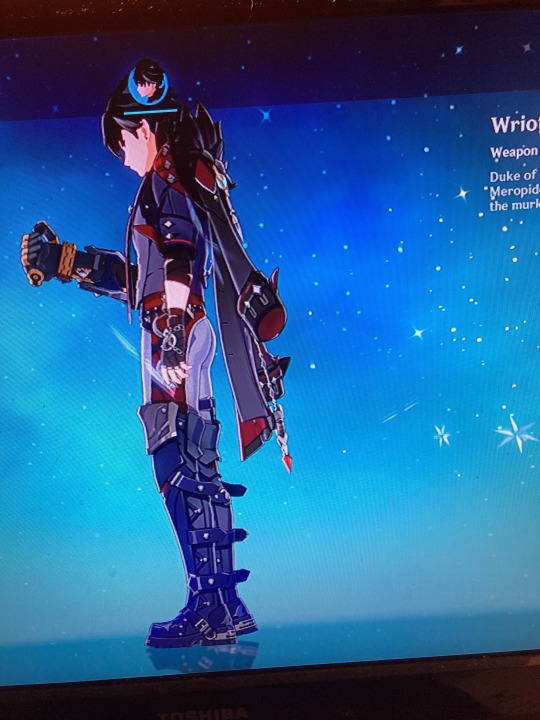
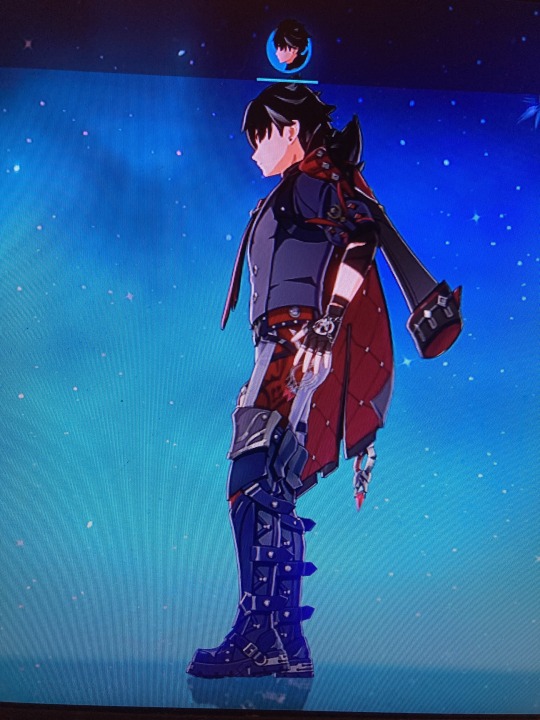
Man has a great ass. No denying that. And a part of it is once again how colors are used to break things up, along with the lighter color of his pants allowing for more depth with how they have the shadows cast on him. It's like they framed his ass essentially.
-coughs-
Now if you'll look at the first image of him again i'll get back to his boots. The armor cuffs at the top of them once again splay outward somewhat and as you go down the leg you'll notice that mot of the detailing is done in such a way to keep forcing your eyes outward. Then the main part of the boot really is just chunky.
In conclusion hoyoverse does a really good job useing shape language and color to add variation to their character models despite using a limited range of actual models. I could probably do a similar rundown with Al haitham, who while not as big looking as wriothesley also feels bigger than say Kaveh or Kaeya despite all the characters i mentioned here using the same base model. Seriously though the take away should be that even if you have limited resources or are trying to reduce them while making something with a ton of characters there are lots of subtle tricks you can use to trick the eye of your viewer (positive)
I'm sure there's someone with a more professional background in character design who could give a more in depth and better articulated run down of all this. I'm pretty much all self taught and just really love art and character design. I could talk about this at length still though with a bit of back and forth since there are definitely things i glazed over.
Thank you so much for getting my brain going Amira! (I've talked my non artist roomate's ear off about this before and they just politely listen so i can get it out of my system)
2 notes
·
View notes
Text
Knives Out
(Or What If…? Steve Rogers Wore Cable Knit)
A joint review...

Firstly, aren't you glad to have us back? We know you missed us, deep down, very deep down. So you're welcome.
Secondly the tag line for this What If?... was a bit of a debacle. Cass suddenly lost her mind about spoilers, so where as What if Steve Rogers did crime? would have made possibly more sense, she insisted we didn't reveal who the villain was on the poster. The cable knits though are honestly a very big part of the film for some of us, who lost their minds in other ways.
This takes us to our third point, which is that the notes made for this review varied wildly between the Shared Brain. Cass made proper film notes, and Becks thirsted. In Becks' defence, when discussing it after she was a bit more articulate about the storytelling, the sets and the all that film stuff. But those jumpers are really good.
Enough of the introduction and on to the film...

This film hits the ground running. We both commented on the excellent dramatic music, and the fact that the house is just dreamy. It’s like, yes the film has started, pay attention and come take it all in. Becks has just had an explosion of words and waving arms, declaring this film to be the most perfect film that has ever been made.
The introduction to all of the characters is just so clever. We go into the most perfect library for interrogation that has ever existed, which is also perfect as it is in this library that the most perfect interrogations occur. And the lies begin here as the audience is told story upon story, mixing and replaying shots as the Thrombeys' show us just what sort of family they are...awful.
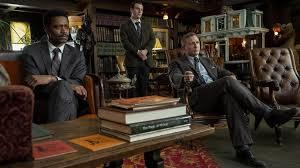
As well as the suspects we are also introduced to the world's best detective team, a man who has had enough of all their shit, another man who is just so excited to be a part of it, and James Bond trying out a new accent. Jokes aside Daniel Craig in this film is excellent. It’s easy to forget what a great actor he is, when all you can bring to mind is James Bond. Cass has just told Becks that he revolutionised the role of Bond, but Becks won't hear a good world said about that franchise - so we are at an impasse.
Anyway, we love Benoit’s introduction. Becks’ notes said, ah James Bond being a tit in the background, whilst Cass lost her mind and started gushing about ‘the presence that man has!’
Needless to say the way the full story is introduced is brilliant. Such great storytelling. The way the same scene is edited and cut slightly differently each time, showing the audience the curated and untrustworthy points of view of each character. The switches and the camera angles telling us as much about the characters as the words they use to tell their own story. It’s just the peak of what good cinema should be. Perfectly encapsulated we think, in this bit of dialogue about Walt’s creep of a son:
Walt: He’s very politically active
Richard: The boy is literally a Nazi
Meg: Alt-right troll dipshit
Walt: Kids these days, the internet
It is also here that Becks begins demanding to see her favourite snuggly murder boy. Cass admits that her interest is peaked when he is introduced as the black sheep of the family, got to have a type, I suppose. The slight difference here is that one of us has kept a grip on their finances for once, and one of us has not.
Quick question, is the vomiting after lying a real life issue? Answers on a stamped address envelope please, because we posed the question and haven’t bothered to investigate further.
We love Marta and Harlen's relationship, the only two half sane people in that god forsake house. Marta is obviously a godsend, a proper caring friend to Harlen. Imagine caring about someone so much that you would protect them even in death? It’s the only bit of true warmth and love felt between two characters in this film, and really sets them apart from the rest of the assholes on the floors below.
Again we want to show appreciation to the house, a character in its own right. Full to the brim with beautiful tat, and secrets that we just adore. We want a secret trick window, long corridors, rooms full to bursting. We want a home that is just stuffed full of every little thing that makes up us.
Cass would also like to take a moment to sympathise with Linda. She too knows the struggles of people clomping about upstairs while she is trying to sleep, but unlike Linda she knows exactly who it is. 🙄
Also we really enjoy Toni Collette playing the shit out of Gwyneth Paltrow. 10/10

Also, is there anything more relatable than storming out in a fit of rage after being told to get a job? Poor Ransom. Becks has suggested she would be his sugar mummy, but Cass has helpfully pointed out Becks couldn’t be as she has no money to keep this man child in cars and knitwear. Spoil sport.
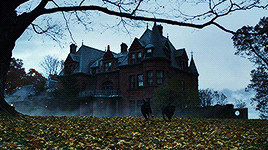
The film at its core is a traditional country house murder mystery, that has been brought shining into the twenty first century. We are still given the joy of watching the sleuths try and pick their way through clues and motives, but with the addition of Marta evading them just a moment before. We love them roaming the grounds, with her managing to cover her tracks just before they get there. Although there is ever the glimpse of bright blue eyes constantly watching in the background, as Benoit Blanc quietly takes in more than he lets on.
The dogs' barking signal the arrival of hotness.
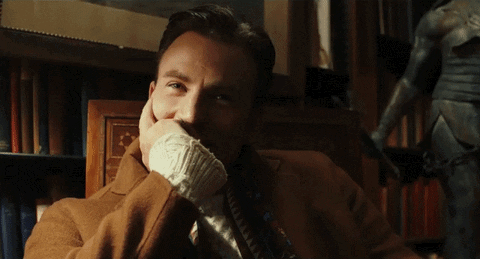
The will reading scene is end to end fantastic. Biscoff, delicious biscoff. The audacity of the entire family to hide their own failings and to unite as one in a vicious little coup. The slap fight. Ransom's face. Eat shit, eat shit, eat shit, definitely eat shit. I'm not eating one iota of shit! The panic and disorientation the audience feels as Marta tries to leave the house, the noise the crowding. Fleeing into the open door of Ransom's Beemer. And finally the darkness creeping in as the family begin to plot. We love that Alan is so desperate to go home that he is happy to be called useless.
Becks would love nothing more than to jump into a sports car and then be menaced in a country pub. So rustic. Cass might be on board too, depending on who's driving the sporty number.
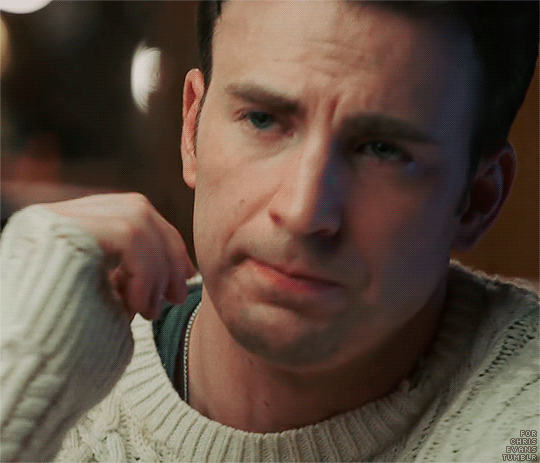
The pub scene shows us Ransom in his full glory. We get fed on cable knit, intelligence, menace, plotting, lying, sleeves over his long fingers caressing his fucking mouth. Cass wishes she could take the keyboard off Becks, taking it up to a third intervention of the week. [I don't think we're laughing about that yet, but at least we're not crying any more. The low blood sugar is making it impossible to pump out any more tears I think. What a fucking mess.] Trying to bring it back a little, it's just another really good bit of storytelling as both the characters and the audience is manipulated down another web of lies.
Another bit of sinister action that we enjoyed is Walt Thrombey visiting Marta's house. The sinister thump of the cane as it impacts the ground, moving ever closer, demanding to overpower the woman in front of him. And we love how she turns it around on him, changes the dynamic so perfectly, leaving him small and bitter and alone.

Then we are treated most wonderfully to the car chase. What a time, it was both ridiculous and thrilling. Ransom calling Marta 'baby driver' nearly had Becks done for but she kept it together, out of professionalism and that... Oh we do love a good car chase, it’s fun and it builds the tension perfectly.
Now, does it seem a sensible thing to blackmail a murderer? We would say no, and are also proven correct. The repeated scene of Fran in the abandoned dry cleaners is great. The first time we see it with Marta and the body it's creepy, dark and so unsettling. The second time with Ransom, the power shifts and we feel it as he takes her life and light out of the room, just to get hold of that report.
It also gives us the little treat of Blanc happily singing to himself in the car. What a fucking delight this man is.
It then leads us on to the finale, the big reveal, better than anything Poirot has ever done. Never has Agatha Christy treated us to lines such as, 'What were the words overheard by the Nazi child masturbating in the bathroom?'.
Not to be a broken record, but honestly the whole ending was just perfect. B Blanc finally telling the tale how it truthfully happened, joining all of the little dots and crumbs we had been fed throughout the film, finally filling the donut hole. The whole donut analogy makes Cass feel hysterical, wave upon wave of joy and shrieks that’s she tries to hold in as it goes on and on. She has likened it to Becks' reaction to Ransom, but we have discussed the subtle differences in that.
The ending also gives Ransom his perfect villain ending. That monologue. We shouldn't use the word perfect anymore in this cursed review but that's what it is, and Becks will fight anyone who says differently.
RANSOM: I want to say this just to you, not to a courtroom of cameras, just to you because you know it's the truth: we allowed you into our home. We allowed you to take care of granddad, to be part of our family and now you think you can steal it from us? You think I'm not going to fight for our birthright, our home, our ancestral family home?
BLANC: *laughing hard* Harlan bought this house in the eighties. From a Pakistani real estate baron.
RANSOM: Oh shut up Blanc, shut up! Shut up with that Kentucky fried fog horn rag-horn drawl. Yeah I killed Fran but I guess I didn't, so what do you have on me. Nothing. What, attempted murder? I get arson for the building, maybe a few other charges, with a good lawyer, which I have, I'll be out in no time. And then you'll see just how much hell I can wreak on your life, you vicious little bitch.
And then he takes the vomit like a real champ. Marta goes off like that little frilly dinosaur in Jurassic Park, and we love to see it.
We then get what our old film-tutors oft referred to as a trippy Jaws shot, and then so much slo-mo drama with that incredible chair in the background. It just looks amazing, as we follow everyone's terrified faces as the knife cuts through the air and down into Marta's chest. And then bounces a few times.

We should also discuss how Becks' notes just end with the line, 'I wish he'd stab me.'
@becksxoxo: I stand by it. He's so angry, with his face, and then he flies through the air and is just there, on her, plunging the blade in, and then back out, and in again, and out and...
@cassandrafey: Oh for god's sake. Do you think you're clever?
@becksxoxo: Alright Cass, no need to be such a vicious little bitch about it.

In conclusion, crime bad, but if done in a nice sweater, crime good.
We've had a lovely time. It’s such a comfort movie (weird considering it’s very murder based but we won't delve any deeper into that, we’re weird women, fuck you), something so brilliantly written, designed and acted, and just a joy to watch.
Bet you’re excited to see what our next convoluted What If…? tagline will be next week ey folks? Stay tuned for more shared brain action!
Love Becks and Cass xoxo
#what if steve rogers wore cable knit?#the shared brain in retrograde presents what if#knives out#i want you to know a conscious effort was made so that not all the gifs were of ransom#but i am a very delicate young woman with financial issues#marta cabrera#benoit blanc#ransom drysdale#hugh did it#movie review#film review#chris evans#daniel craig#ana de armas#toni collette#jamie lee curtis#christopher plummer#frank oz#don johnson#michael shannon#cable knit#steve rogers#the perfect film#five stars#hugh ransom drysdale
49 notes
·
View notes
Text
Film Details #1: The Stairs in The Red Shoes
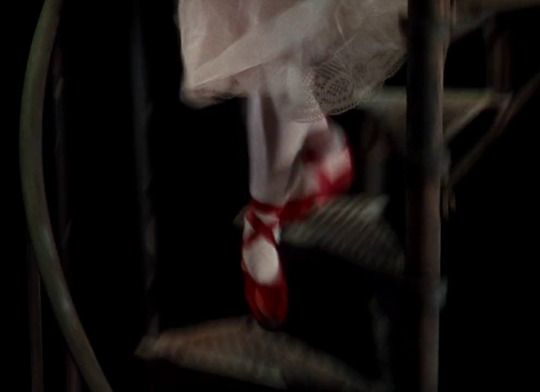
Film Details is a blog series of posts focusing on a specific detail in a film. Details may vary from a single shot, a particular cut, or a piece of sound to individual scenes, objects, and other elements in mise-en-scène as well as larger-scale motifs in the film under scrutiny.
One of the most memorable shots of The Red Shoes (1948), a mesmerizing classic of fable and ballet cinema, is actually a subtle combination of two identical shots by means of an almost unnoticeable jump cut. It is the image of Moira Shearer’s legs as she is rapidly running down a narrow spiral staircase. The shots are in a fairly small scale and framed in a manner that crops the rest of the character’s body so that attention is distinctly placed on the radiant red shoes on Shearer’s feet. Yet the background, or not just a simple backdrop of course but a space in which this event occurs, is also important: the staircase. Director Michael Powell has explained how he achieved the trick together with his crew. In order to capture the quickly moving legs of the actress, they had to first commission a separate spiral staircase to be moved and filmed, then make a rotating mount underneath the staircase so that they were able to move the spiral staircase in synchronization with the downward movement of the camera on the crane without losing the actress behind the edges of the staircase [1]. The impression is impeccable and alluring. There is an enigmatic sense of movement that feels impossible in a way that strangely resembles the viewing experience of a similarly enchanting, though very different, trick shot of a staircase in Hitchcock’s Vertigo (1958). What should draw specific attention to the staircase at this crucial moment in The Red Shoes, however, is that this is not the first instance of the in-between space of transition in the film. There are plenty of steps along the way.
Before compiling, analyzing, and interpreting the many stairs of The Red Shoes, it is important to provide a short reminder of the film’s basic story line. It is crucial to bear this in mind because it is the story and the characters’ core relationships that introduce the film’s key theme that is articulated and structured by the staircase motif.
The Red Shoes is a film about the conflicts of life and art. It tells the story of a young aspiring dancer Vicky Page, played by Shearer, who is hired by Boris Lermontov, played by Anton Walbrook, to his renowned ballet company. During the time that Vicky is hired, Lermontov also employs an up-and-coming composer named Julian Craster, played by Marius Goring. Together they achieve great success, both creatively and financially, when Lermontov produces a ballet based on Hans Christian Andersen’s fairy-tale The Red Shoes, starring Vicky and with music composed by Julian. To much of Lermontov’s disappointment, however, since he sees other matters besides art as destructive to the creative enterprise, Julian and Vicky end up falling in love. Lermontov fires both of them in hopes that Vicky would leave romantic love behind and come back to the lure of the red shoes and ballet, as she eventually does. Yet, Vicky remains torn between the two men, who represent her conflicting desires for love and art, and in the end dies by falling under a train. She is, just like the protagonist in Andersen’s fairy-tale, unable to take off her red shoes; she is incapable of shaking off her pernicious passion for art. The story is rather simple, but it is elevated by a cleverly treated intertext of the Andersen story. The theme is as old as mankind, but Michael Powell and Emeric Pressburger craft a unique cinematic discourse to articulate the theme and give it new meaning. Even more so, the film is rife with details that have this very effect. The staircase motif is one of them.
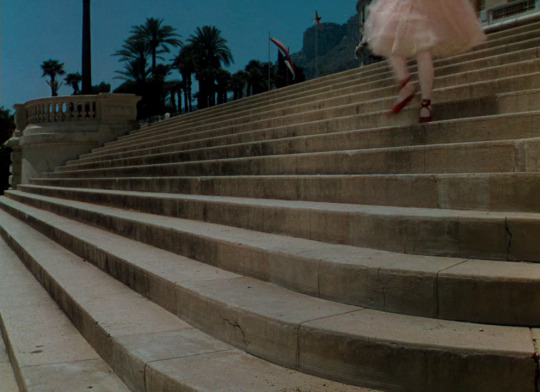
There is a plethora of stairs in the film. There are the stairs on the balcony to which Vicky runs and from which she falls to her death after leaving the rapid plunge to the spiral staircase behind. These steps on the balcony (and not the spiral staircase) are in fact the real last stairs of the film. More towards the beginning of the film, there are also the almost off-screen stairs leading to the party held by Vicky’s aunt in hopes of attracting Lermontov’s interest in her niece who is an aspiring dancer. There are the behind-the-scenes stairs leading to the stage at Covent Garden where Julian goes to after Lermontov has hired him for Ballet Lermontov. There are the further steps Julian climbs with Irina Boronskaja, the leading dancer of Ballet Lermontov who eventually leaves the company due to her marriage (exemplifying what Lermontov fears for Vicky). There are the stairs behind the stage which the dancers, including Vicky, walk down after the first class is dismissed. More towards the end, there is an underground staircase which leads to a platform at a railway station which Lermontov climbs to reach his train only to discover Vicky trying to convince him that there is room for more in her life than just dancing.
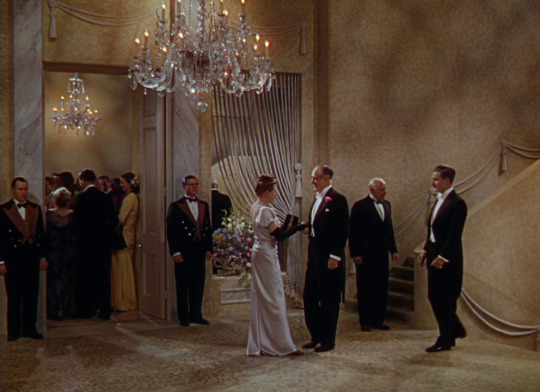
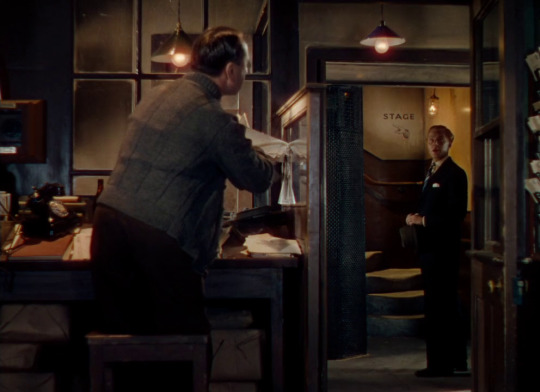
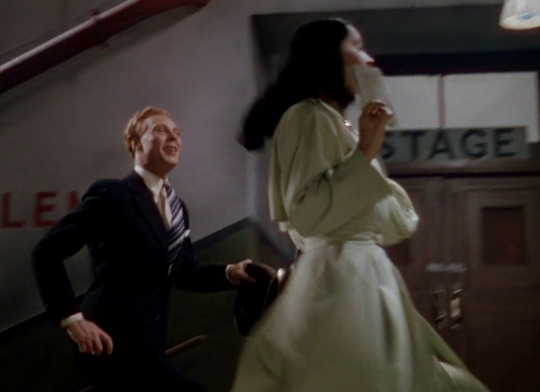
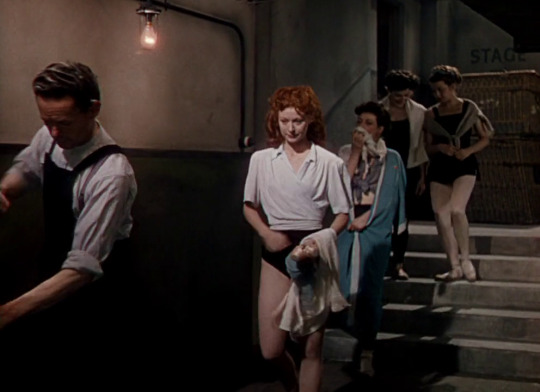
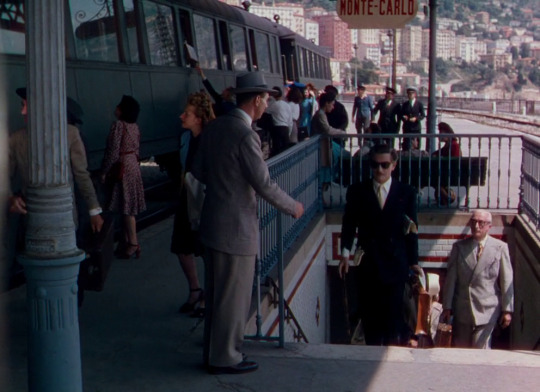
All these scenes concern, more or less explicitly, a movement between the outside world of real life and the dream world of art. I shall flesh out this interpretation in more detail below. It is perhaps more direct in scenes where characters move through stairs to the stage or away from the stage and it is perhaps less explicit in scenes such as Lermontov’s arrival to Vicky’s aunt’s party or his arrival to the train platform. But it is there, nonetheless: Lermontov’s confident walk on the stairs precedes Vicky’s attempt to reconcile the conflict; she tries to make Lermontov agree to let her dance as well as live her love life.
However, one scene not mentioned above is especially characteristic of this thematic function of the staircase motif. During the first day that Vicky and Julian are working for Ballet Lermontov, Lermontov climbs the small stairs of the theater from the auditorium to the stage. This moment, though seemingly minute especially when considered in the context of the staircase motif, is revealing in terms of the thematic function of the stairs in the film. In the long take, Lermontov first passes Julian trying to reach him in the auditorium and then Vicky trying to contact him on the stage. Lermontov moves from the shadows, that is, the real world, to the limelight of the stage, the dream world of art. It is this movement between these two worlds that is reflected by the many stairs of The Red Shoes.
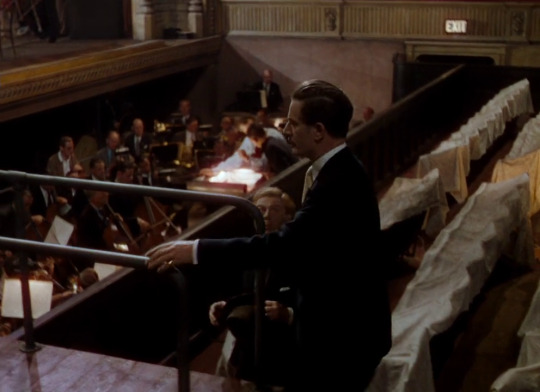
All the stairs mentioned above are quite minor. That is to say, one does not really pay attention to them unless one is specifically looking for them. Even the thematic function just outlined might seem a little vague at first. But it becomes more salient, I believe, when one looks at these instances in the broader context of the staircase motif with its most important manifestation. To be more specific, there are three scenes in The Red Shoes in which stairs gain increased significance: there are the entrance stairs of Covent Garden in the beginning, the stairs of a castle-like building in the middle, and the stairs in the end (the spiral staircase and the stairs on the balcony). Since I have already described the final scene with the spiral staircase and the stairs on the balcony, I will start by describing the beginning and middle scenes both of which have not been mentioned above.
The stairs in the beginning are actually the first thing that are seen in the film. The film begins with a low-angle shot of a staircase leading up. Off-screen noise of a crowd from the outside is heard on the soundtrack. A porter enters the screen space at the top of the stairs and walks down a few steps. A cut reveals two guards holding the door shut below the staircase. The porter tells them to open the doors and let the awaiting crowd in. The crowd is a group of excited students about to lose it over ballet. It is opening night for Ballet Lermontov at Covent Garden. The camera follows the intense running of the students through the stairs until it settles on a corner to capture their enthusiastic movement -- which even ends up tearing a Ballet Lermontov poster for the show on the wall. The real world that is left behind is tactile, palpable, whereas the world of art is anything but. The audience is there to sit still; they are there to see and to hear, as they very clearly emphasize in dialogue with each other. It is this opening scene that establishes the theme of movement between the two worlds through the staircase motif.

Between the scene with the stairs in the beginning and the scene with the stairs in the end (both the spiral staircase and the stairs on the balcony), there is appropriately another chief scene involving stairs in the middle of the film. It is the scene where Vicky, all dressed up in a beautiful blue dress with an adorable tiara, accentuating her red hair in glorious Technicolor, is summoned by Lermontov to attend his company in an eerie castle-like building straight from the pages of a fairy-tale. Arriving to the scene, she climbs a stairway only to find a massive set of steps covered in grass. At the top, there are more stairs to be climbed. And what awaits her after all these steps? Lermontov telling her that she will be cast in the lead role for his new ballet based on Hans Christian Andersen’s fairy-tale The Red Shoes. The length of passage from the ground to the higher top where Lermontov awaits seems to reflect the hardship that entrance to the life of art takes. At the same time, however, the duration of the journey to the top expresses the detachment of the world of art from the real world below. Furthermore, the long stairway covered in grass has a mystery to it, enhancing the transition to the dream world of art. It is as if the film took a momentary pause to emphasize not only the narrative importance of this turning point but also the enchantment of art, which is both alluring and horrific.
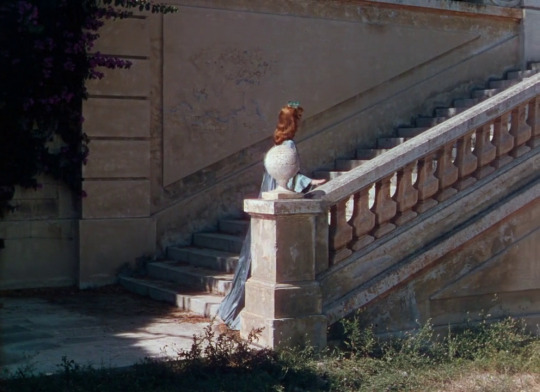
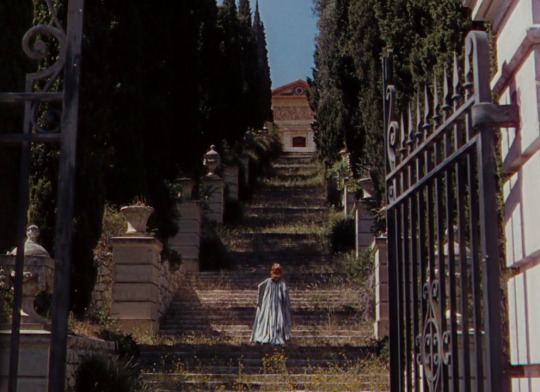
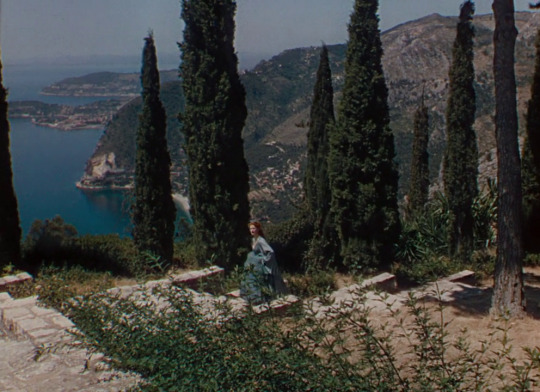
As said, the stairs in these three scenes are more noticeable. They articulate, perhaps more explicitly, the theme of movement between the real world and the dream world of art. In the opening scene, excited students rush the stairs, leaving the tactile real world behind, to get closer to the dream. Julian Craster, the composer who Lermontov eventually hires for his company and with whom Vicky ends up falling in love, sits on the balcony, listening to the music. Vicky, however, is closer to the stage; she is already enamored, perhaps too enamored, with the dream world of art. She is the one to tell Lermontov that the way others justify continuing to live is how she justifies dancing. To her, the raison d’être for human existence is equivalent with the raison d’être for dancing. And, of course, she is the one who ends up dying for it. In the scene mentioned just above, the scene where Vicky walks up the high stairs of the castle-like building to hear Lermontov’s life-changing announcement, there is a similar sense of inter-world movement. Vicky is dressed as a princess, not for this occasion that has come as a surprise to her; she climbs the stairs covered in grass to a castle; she learns that she will be starring in a ballet based on a fable. The fairy-tale connotation could not be more unambiguous. The real world is left behind as the character is elevated (also concretely via the long stairs) to a spiritual plane of art. The fairy-tale aesthetics are used to further highlight the detachment of the world of art from the real world, a detachment that is, as said, both seductive and frightening.
In both of these scenes, characters move closer to the realm of art. In contrast to them, the famous image of Vicky rapidly running down the spiral staircase conveys an opposite kind of movement. This is not just to point to the simple fact that people are running or walking up in the first beginning and middle scenes, whereas Vicky is running down in the last scene, but to make a metaphorical observation about these kinds of movement. In a word, Vicky’s rapid run is her fleeing the dream (her dream) rather than getting closer to it. Following the scene where she is practically torn apart by Lermontov and Julian, the former embodying the dream world of art and the latter the real world with romantic relationships, Vicky is struck by a feeling of horror as she wobbles toward the stage escorted by her dresser. She -- perhaps controlled by the red shoes like the girl in the Andersen story -- starts to withdraw. She rushes away and storms to the spiral staircase. The image of her legs racing the stairs represents her fear, her uncontrollable need, and her conflicted desire to get farther away from the dream world of art that means everything to her, but also, in the same breath, her conflicted desire not to leave the art world that has started to consume her. The ambiguity of what is in fact happening in this finale (is it Vicky’s own free will or the spell of the red shoes? Is Vicky running away back to her love or is she running to her death?) emphasizes the unresolved conflict of art and life that torments the protagonist.
What is striking about the spiral staircase in contrast to the other stairs in the film is its surreal dimension. When one sees stairs in the film, one is quite sure of their location and spatial relation to the other spaces. This is not surprising at all because stairs are precisely a connection link between two or more spaces, typically between floors. There can be clear visual cues such as an arrow sign and the word “stage” on the wall reminding us where the stairs are leading or cuts from previous scenes to subsequent scenes that provide spatial context for the stairs. Such is the case, for example, with the scene where Vicky is training with the other dancers of the company. The scene ends with the choreographer shouting “class dismissed!” A cut shifts us to the behind-the-stage stairs which Vicky climbs down (see the image above). One can see the word “stage” on the wall in the background. The camera follows Vicky as she moves farther away from the stage until the camera stops at the music rehearsal room where the next cut shifts us. For another example, take the scene with the castle-like building. A cab driver picks Vicky up from the hotel. A long drive takes her to an unknown destination, but shots of the beautiful natural environment give the spectator a spatially coherent sense of the journey. After the drive, Vicky is then seen at the beginning of the first stairway which she starts climbing; next, a cut to movement shifts us to her arriving to the top of these stairs where she opens a gate, in a mobile following shot, to the huge flight of stairs covered in grass. Finally, a dissolve shows her arriving to the top of yet another staircase, which eventually leads her to Lermontov. In both scenes, the spatial relations are very clear. No such cues are available for the image of the spiral staircase.
After the shot of Vicky running away in fear, there is a cut to the conductor of the orchestra starting The Red Shoes ballet. The next cuts shifts us to the spiral staircase whose exact location in the building remains a mystery. The following cut does not help provide context for the spatial relations either: the camera remains on Vicky’s legs in the red shoes, with the rest of her body cropped off, walking an unknown hallway and climbing down a few steps until she arrives to the stairs on the balcony which lead to the more familiar space of the balcony over the railway tracks. In addition to the shots preceding and following the two combined shots of the spiral staircase, the shots of the spiral staircase themselves further enhance the spatial ambiguity. Given the velocity of Vicky’s flee and the duration of the two shots, one would assume that the spiral staircase covered quite a long journey. It is hard to see where exactly in the building such a large spiral staircase would be located. It is possible, of course, but it is not clear by any means. It is a surprise to the spectator, and that surprise is precisely the point.
More important than the shots surrounding the image of the run in the spiral staircase is, of course, the overall uncanny impression of the image of the spiral staircase itself. By combining the fast movement of the actress with the synchronized movement of the camera as well as the unnoticeable movement of the spiral staircase, the image gains a totally unique sensation that is quite difficult to be put into words. The fact that the actual staircase in the physical space (of the studio setting) has been moved with the help of a rotating mount while filming enables the camera to capture the actress’ movement in a different way than it would had the staircase remained still. However, since the staircase does not move in the diegetic space (i.e., the space of the fictional world where the characters act), the visual impression is perplexing to say the least. This only highlights the surprise factor of the cut to the spiral staircase. The surrealism of the image emphasizes that the protagonist’s flee is not really physical or concrete but metaphorical. In the poetic space of the film, the character is detaching from the dream world of art that means everything to her -- from the world whose detachment from reality had been established at the latest with the fable-like stairs covered in grass. The unresolved conflict can only end in death.
In addition to the thematic trajectory outlined by these three scenes (first steps toward the world of art at Covent Garden in the beginning, then entrance to that world via the stairs covered in grass in the middle, and finally an escape from its consumption of the soul in the spiral staircase in the end), it is worth noting that the famous seventeen minute ballet sequence of the film also features stairs. That is, stairs are involved significantly in the production design of not only Powell and Pressburger’s The Red Shoes but also in The Red Shoes by Ballet Lermontov. There is a staircase in the background of the main milieu of the ballet, which is first being walked up and down by two women. In the end, the girl with the red shoes, played by Vicky, collapses on the stairs after being exhausted by the red shoes. Having been released from the curse of the red shoes by death, Vicky’s body is finally being carried by a man toward the stairs.
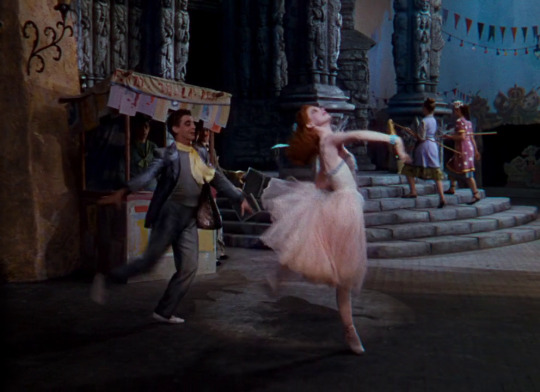
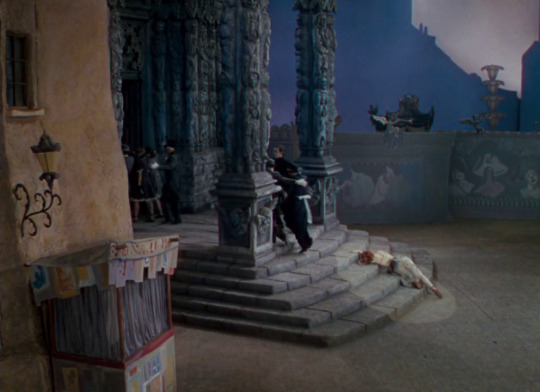
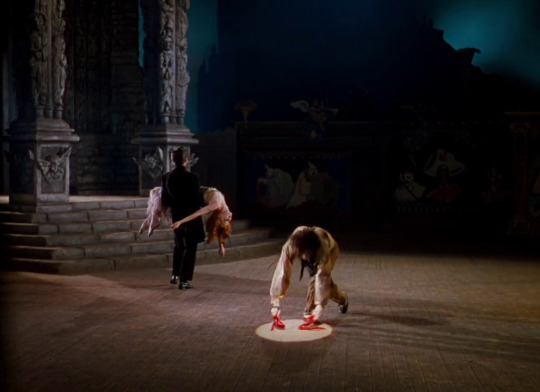
Although these uses of the staircase motif take place in a story within the story (the Andersen story as a ballet performed by characters in the film), it is quite interesting that stairs appear in the beginning and the end of the ballet, just as in the film itself. Stairs in the ballet also connote transition and, specifically, death. It is as if the stairs, which in the first instance are associated with entrance and movement, eventually turned into a gateway between two worlds. Vicky is first brought to the world of art (the first instance of the stairs in the ballet), then dies for it, and is finally being taken away from it back to reality (the last instance of the stairs in the ballet). This affinity between the ballet and the film should not come as a surprise, of course. For the ballet, to a very large extent, reflects many of the events in the film, including Vicky’s budding conflict between Julian and Lermontov.
The staircase is an in-between space between spaces. Movement in the staircase thus usually connotes transition. Here, I have claimed that the stairs in The Red Shoes operate as a metaphor for the characters’ (mainly Vicky’s) movement between the real world of life and the dream world of art. The movement is oftentimes casual, but even then it exemplifies this thematic function. In scenes where the movement is less casual and the staircase is more salient, that is, the three scenes in the beginning, middle, and end discussed above, the articulation and structuring of this theme is more conspicuous. Vicky is first pulled toward the dream world of art by its mysterious lure in the first and second of these scenes, which establish the detachment of the dream world of art from reality, but in the end she is almost pushed away from the dream world by its even horrific enchantment with which she once identified so strongly. In the astonishing shots of the spiral staircase, the link between the worlds has broken down, which is reflected by the eerie movement in the shots and the ambiguity of the relations to other spaces. The image is a shock. The extraordinary effect of the image of the run through the spiral staircase, a spatial link both displaced and uncanny, expresses this ambiguous and unresolved conflict of art and life in the life of an artist.
Notes:
[1] Michael Powell tells this anecdote to Peter von Bagh at the Midnight Sun Film Festival in 1987: “At the end of the film, when the girl runs to her death in the red shoes, she gets out from her dressing room. I thought that it would be terribly boring if she just ran the stairs down in an ordinary way so I had a spiral staircase of roughly six meters made for the scene, the likes of which are used in industrial facilities. I asked Moira if she could run down the stairs in her ballet shoes. She told me she could. The camera had to shoot the running from a descending crane. I asked Moira to run as fast as she could because I wanted the shot to be as short as possible. I gave Moira the signal to go, and she ran the stairs down faster than the camera was able to follow. She beat the camera by roughly 20 film frames. The cinematographers were ashamed. She had to run again, and this time the camera kept up with her, but when Moira ran the spiral staircase, she was of course momentarily concealed by the staircase for every lap. Since the camera was unable to turn around the staircase in the same speed, we had to have a rotating mount made for the staircase whose speed could be controlled so that Moira was constantly kept in front of the camera. We told Moira that now she could run as fast as she wanted. She ran and won the camera again by two seconds. Later, once we had the shot, my editor Reggie Mills asked me if we could lengthen the stairs. I answered no, unless we would get a new staircase. But the shot was too short as it was so we decided to develop it twice and then cut the pieces together so that it would look like one shot.” (Peter von Bagh, Sodankylä ikuisesti [Sodankylä Forever], WSOY, 2010, p. 55; my translation from the Finnish text.)
19 notes
·
View notes
Note
@infinity2639 essay was really well made, it points out a lot of very true and concerning things, you should take a look at it.
for background, I wrote this chubby shouto just as a way to practice. it was done with the intentions of only being read by forty people at maximum honestly and it did pretty well for something I wrote in less than an hour, except I had one particular nasty comment from @infinity2639. now I won’t always say that comments are nasty, but they held no restraint in telling me that I was in the wrong for writing something like that - which of course they’re entitled to their opinion, but seeing that they were the only person to have this opinion i sought out how to improve on my writing because they spoke of how simple it was to fix. they then wrote a 21 paged “essay” which held no actual commentary on how to avoid writing such things, but instead ripped into every sentence and every word and chose to explain how it affected them. since it was a very me, me, me essay, I figured it was best to ignore it because I learned absolutely nothing from it other than the lengths people go to. so... consider this my response, and don’t come back asking for more details because I will not give any more.
so aside from the fact that the essay was written entirely on the basis that this one person decided to continue to read something that obviously triggered them instead of simply clicking off and realizing that this fic was not for them, let’s address these true and concerning things that they “pointed out.”
first and foremost this was a drabble, it was written on my phone and due to the nature of the content I went as far as to ask many people on how I dealt with the issues involving self image when you consider yourself to be fat/chubby/obese. I knew the dangers of what i was writing because yes, i’m not “qualified” enough to write on it from readers perspective, but I figured that maybe I could handle it from shouto’s. I got only positive reviews and feedback so I figured it was okay to move on.
this essay of theirs was obviously very, very personal - to the point where I will go as far as deeming it as being gatekeeping (this was supposed to be an essay on how to properly write on the topic of being self-fatphobic & writing healthy relationship dynamics, not a rant on how much they hated me). this was their opinion and in no way shape or form will I put them down for feeling this way. however, I will say if it made you uncomfortable yet you continued to read, it is not my fault nor shall you pin it on me.
you control your exposure to the content you come across.
the fact of the matter is that infinity and their supporting team of people are those i’m clearly having issues with right now, so it does little to make me believe that this is an actual issue and not boiled over emotions surrounding the ordeal on outside, uninvolved drama. i will admit that those own defensive emotions of mine are unwarranted because if you feel so strongly about my one work it doesn’t matter where you’ve aligned yourself, so i do apologize for initially not liking you - but seeing what you wrote and who you ranted to in those screenshots, i guess i wasn’t far fetched in my initial stance on you. the biggest thing again is that you decided to read something on chubby!shouto, you decided to continue to read through a fic that so very made you uncomfortable to the point that you were having panic attacks, you decided to finish it. I didn’t make you, I didn’t force you. when fics make you uncomfortable, click out of it. it is not my job as a writer to display only honey sweet intentions and if you’re expecting that, unfollow me.
moreover, i’m not an expert on this entire psychological thing - and I will admit that the only intelligence I have on it relies on things ive read, content i’ve watched, and my own personal feelings. obviously it wasn’t the best, I never have ever claimed to be someone who perpetuates only the cleanest and healthiest things even if I try to be well informed on the things I write because yes, while I don’t think you should learn from fiction, I understand that there are some people who do and I try to keep those in mind. the only thing I was trying to do was come at the fatphobic standpoint from a different angle. personally, if I say i’m fat, I don’t want people telling me that i’m not because I know the truth if I am or not. to me, fat has always been equated to being ugly/uglier. of course social norms today are evolving, but being fat is only deemed attractive if you are one curvy bitch, and I know for a fact that is not seen in every single person, so I tried a new approach. at the end of the day my opinion still is that being fat doesn’t make you ugly, and if that’s still an issue for you, are we really sure that i’m the fatphobic person here??? cuz it sounds like maybe it might actually be internalized in you.
but... it’s just.... concerning to me that the only people with your issues regarding my chubby!shouto post is basically you and only you. in the time it was posted I have gotten only positive reviews and anons. plentiful of anons and accounts have thanked me for my portrayal of the topic of being fat (after all, I was not discussing or debating the issues and technicalities of being fat, chubby, or obese) and going so far as telling me that your essay was complete bullshit, which I felt no reason to answer because still after all this time I keep my haters feelings in mind.
and i’m actually not a med student :( sorry that you esteem me so high that you believe that at 20 years old i’m already in medical school - so no, I don’t know the ins and outs of all of these things and i’m sure old doctors probably will fatshame and be much more fatphobic then I ever will be because again topics of being fat were different back then & fat itself isn’t universally applicable per person per case because everybody and person is different. people who have bmi’s far greater than mine are healthier and more fit than I am which is what matters at the end of the day. fat does not equate to health and beauty after all.
now the issues with the abusive relationship tendencies I guess you can pin that on me and my inability to elaborate my thoughts and intentions. verbally attacking was meant to be teasing but it didn’t sound correct/I couldn’t remember the word for teasing when I wrote it. i’m not always entirely articulate and I do fumble with my words and phrasings - as does anyone who writes for fun and not for a job - and if it hit you that deeply, i’m back to my square one thought!!!!!
stop reading things that make you uncomfortable :) it’s really not that hard at all, I promise.
193 notes
·
View notes
Text
The Mandalorian Chapter 11; the rewatch edition
I have found a bit more enthusiasm for this one on the rewatch, so here goes!
- din snapping ‘I’m trying my best here!’ in a vaguely annoyed tone as his entire ship is going up in flames around him because he mostly doesn’t get angry as much as sulky... the height of cinema
- I love frog husband’s clothes, because they’re in a very similar style and colour scheme to frog lady’s but also incorporate the knitwear we see on the people of trask, so it both underlines his belonging with her and implies that he’s been on this moon for quite a while, they may have been apart for some time

especially his scarf is a darling detail and there’s a bit of contrast in texture to it next to his wife’s, it’s nice. he’s wearing a similar kind of vest to what we see on the fishermen later, too
- I think my favourite part of this entire episode (well second after din cradling the baby against him after nearly drowning) is just the design and Vibe of the planet and especially this harbour

for one I LOVE that it’s shown that even in the middle of the day it’s dark enough that the electric lights are still on when it’s overcast (it reminds me a bit of norway during the winter, actually, when dawn just never quite breaks and then slinks off in embarrassment before it’s even noon). and there’s also the... sails? nets? hanging around looking almost like flags, which are very Aesthetic but god knows what they’re for. maybe for drying fish on in the summer?
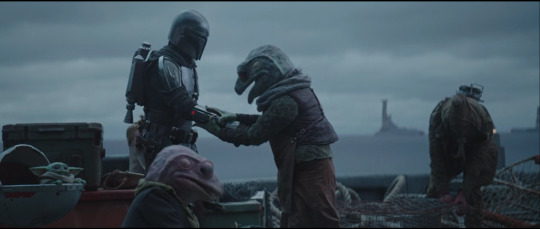
I think the building in the distance behind frog husband’s back here is a lighthouse? or it could be one of those towers for loading you see when they scout out the empire ship too, I suppose!

and one for my strange obsession with Texture on this show: these fabric-covered crates!!! they look exactly as dingy and moldy as you’d expect them to be in this climate, I wonder what they’re for (& I vaguely want to touch them)
- from the sound of it din’s vibroknife is uh ‘on’ when he pokes the squid thing, and he also goes for the tentacle the furthest away from the baby <3

proof the calamari flan have been scratched up a bit during all that time in din’s pockets! (the attention to detail in this show sometimes istg)
- this is 100% me reading too much into things again, call the overthinking police I’ll do my time meekly lol, but the boat looks a little bit like the mudhorn signet from this angle:

again din keeps his hand on or sooo close to his blaster in this entire scene, he knows this is sketch as all hell
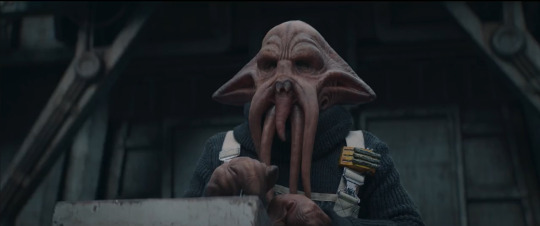
a) once again I want to praise the effects team for how GOOD the aliens look in this episode holy shit and b) the hell is this dude wearing on the straps of his overalls tho
- the dude mando (axe woves) uses his little... wrist launcher thing to shoot with to finish two off the fishermen, so my theory that they can be loaded with other things than the whistling birds for slightly less effective use (maybe without the level of honing we’ve seen din’s be able to do?) is looking good!
- din actually has quite good form when diving into the water, I’m guessing he can swim at least tolerably when not in full armour, being stabbed at from all directions, having just had his son eaten by a sea monster and also being trapped in with said sea monster (I’m a strong swimmer and I can tell you that there’s a reason they make you swim with clothes on from time to time to see how hard it is, it sucks. with metal plates strapped all over you as well? yeah good luck) people don’t tend to hit the water that gracefully without some kind of training in my experience lol. might be some of the training with the jet pack has carried over too, considering he throws himself off that cliff in chapter 12 with similar confidence?
it’s interesting that they’re once again showing us a threat where the armour doesn’t help and even hinders him. we’re so used to the ways it can make him near-invincible, but it can also drag him down (literally, in this case. aha ha ha. well if I’m not here for my own entertainment then what am I here for honestly)
- din’s voice sounding like he’s just on the verge of crying as he cradles the baby (and the sound he makes as he realizes the baby’s alive) is my kryptonite, turns out. fucking breaks my heart into tiny pieces every time, I would die for this man and he wouldn’t let me
- in support of din’s paranoia: so far this season we haven’t been able to go five minutes without someone talking about peeling the precious beskar off a mandalorian corpse, I can see why his mind was primed to move in one particular way there
- I think the fabric of din’s cape has been treated with something that makes it waterproof; the water seems to pearl on top of it rather than soak in! can you imagine how heavy it would get if it did absorb water tho christ

(a bit hard to see at this size but that’s what it looked like to me close up anyway! could also be that it’s wool and that’s why it looks that way but I prefer an elaborate sci-fi explanation here, because it doesn’t look particularly weighed down afterwards) might also explain why he doesn’t seem worried about it catching on fire when he uses the jetpack haha, maybe this is something the mandos do with fabric they’re going to use for a long time
I also enjoy part of the gambeson/undersuit thing poking up from under the shoulder pauldron and cape; I think this is about as disheveled as we’ve seen him since immediately post-mudhorn
- the sound mixing in this scene, where din’s breathing is layered a bit over everything else so you almost feel like you’re in the helmet with him listening to what the others are saying........ oh my GOD, it embeds you so deeply in his POV but so subtly
- not to be biased or anything... but din and the armorer’s armour design is so vastly superior to these guys it shouldn’t even be a competition lol
din looks like an honest to god knight in shining armour except also sci-fi western and the armorer looks like a fucking war goddess from a time beyond memory; the clone wars mandos look like high end cosplayers (eh maybe it’s just my dislike for the boobplates that has me so 😒 lol. also a lot of dudes were very shitty about that whole thing and I don’t say anything but the ‘vaguely-concerned will remember this’ telltale message pops up in the corner every time)
moment of saltiness over: I do like the differentiation between their individual character designs

the differences in body type and helmet design is nice! they look like a unified team, but with individuality. I suspect the ladies have those belts and their armour plates on the hips instead of the front of the thighs to emphasize the ‘female’ silhouette, which. okay fine whatever
- bo katan looks very pointedly down at the baby after saying ‘a group of religious zealots who want to return to the ancient ways’ which makes me VERY nervous for reasons I can’t quite articulate
- the mournful guitar version of the mando theme as din watches the sunset...... hmmmmngh (this might be some Symbolism happening to us folks strap in for the identity crisis he still hasn’t processed)
- I Cannot get over din being so unimpressed by and uninterested in bo katan’s ‘retake mandalore’ sales pitch from literally the first moment dfhasdkjfhsad sorry lady kryze this man just does not do main quest shit, he’s all side quests all the time and that’s why I love him
- as someone who after chapter 8 wrote a whole-ass fic that was wholly & exclusively about din telling the baby he’ll always come back for him... some of the shit he’s been saying this season does feel like it’s been written to mercilessly victimize me, personally and specifically
- guessing this structure in the background is the traffic control tower! doesn’t really matter, I just thought it was neat

- this part of the soundtrack is called ‘ship o hoj, mandalorians!’, which I found incredibly charming haha (it’s ‘ship ahoy’ except how you write it in swedish, good one herr göranson)
- bo katan is vague about who exactly the new mand’alor would be if they took back mandalore to begin with, she doesn’t specify she is planning to be the ruler until she’s already got din on the ship and in no position to refuse to help. gotta respect the grift at least lol
I do love her voice, though, it reminds me a bit of jennifer hale as shepard
- “I need to get back to my ship, with the foundling” your honor I uh love him so fucking much
- frog lady stroking the baby’s back a bit as she holds her hand behind him to make sure he doesn’t fall backwards while playing with the tadpole ;___________;
and also frog husband and frog lady reaching out to hold hands and frog smooching as din and yodito leave ;____________________________________________;
- when din says the exasperated “mon calamari. unbelievable” line, the baby makes that little blowing a raspberry sound he does as if to agree ‘uh-huh unbelu -- unbelly -- unbelievable dad smh’ and it is very very adorable
- there’s quite a bit of Stuff in the concept art that didn’t make it in this time around; I wonder if maybe they cut some stuff for pacing or whatever and that’s why this episode is so short? water leaking into the cockpit of the razor crest, something that looked a bit like whaling going on on the docks and more spaceships taking off (maybe there were originally meant to be some smaller ships defending the big empire one?), there’s quite a bit here
59 notes
·
View notes
Note
i have to wonder if there's an implication that can be drawn the other way around wrt playfulness and stress - not that un-playful individuals experience stress more acutely, but that people who experience stress more acutely become less and less playful. i have intense, disproportionate shame/fear reactions due to Childhood Trauma(tm) and it's inhibiting as fuck - my work with my singing teacher to relax and (though i've never framed it this way) play(!) w/out embarrassment has been (1/3)
one of the most healing things for me... so i think there's this nexus of inhibition & confidence/security & perspective/scale & playfulness & resilience. to be playful you have to be a bit silly and vulnerable and willing to take a risk on doing something "wrong" i.e. not take yourself too seriously, but if you feel chronically unsafe you'll take yourself & everything else too seriously and want to do it "right" so you minimize the perceived risk of harm. going back to my singing teacher (2/3)
the most important thing she did for me was create an explicitly safe, non-judgmental environment where it's not only ok but even desirable to "fuck up" and "look/sound stupid" and to reinforce that message multiple times. so anyway that quote just made me think that "don't take things/yourself too seriously" sits at this interesting intersection between increasing playfulness & coping strategies for emotional damage. sorry to ramble about it in your ask box lol! (3/3)
*
yes I think this is so so true!! all of this, lol, but especially the part about how acute stress can make it increasingly difficult to be playful. i have written a lot about working through internalized shame here in the past, and especially about the ways that shame causes you to both physically and emotionally shut down parts of yourself. (i actually gave a talk about this subject recently! it was like, a layman’s intro to the neuroscience of shame, with a specific focus on how shame responses affect people’s ability to learn & to connect socially with others in learning spaces.)
i do just want to clarify that the excerpt i posted was from a study that was very narrowly focused on answering the question: “is there a link between playfulness levels and positive/adaptive coping mechanisms in responding to stress?” the study wasn’t designed to answer larger questions about what kinds of life experiences might produce higher levels of playfulness vs. make it difficult to be playful (such as past trauma, not having one’s basic needs for security met, etc.). in the conclusion the authors note that their findings (i.e., that playful people seem to be more able to readily access and use positive coping mechanisms) means that we should be doing more research on how to cultivate playfulness and how to help people unlearn maladaptive coping mechanisms like self-blame. so the point of the study was not to blame individuals or place the responsibility on individual people (“if you could just lighten up, you wouldn’t be so stressed / unhappy / bad at coping!”). it was more like, an attempt to establish that playfulness (as a way of engaging with the world) seems to be associated with all of these positive ways of coping and managing stress, and so we might want to research playfulness more deeply and/or focus on cultivating it in college students.
so i think you are absolutely right that when we talk about playfulness it’s important not to think of it as something that something people just “have” or don’t have (detached from any consideration of people’s backgrounds, lived experiences, etc.). and we also want to avoid pathologizing its absence (“if you don’t have a playful attitude then there’s something wrong/flawed/messed up about you that needs to be fixed”). my research is focused on understanding how we can better create learning environments like the one your singing teacher has created for you -- i.e., spaces where people feel more secure and less vulnerable to scathing or hypercritical judgment; where failures and mistakes are encouraged & normalized as a natural, healthy part of the learning experience; where instructors are modeling self-compassion and deliberately not using shame-based methods; and just in general, where students are getting the kind of gentle, compassionate, consistent messaging you describe receiving from your teacher. basically I’m interested in creating classrooms that provide the stability and consistency people need in order to learn adaptive coping mechanisms that will serve them well outside of those learning spaces.
i think these questions are so important because most college instructors are VERY aware that our students come into our classrooms carrying many different kinds of trauma—whether it’s the more extreme forms that we tend to think of when we think about trauma (childhood abuse, sexual assault, trauma experienced by combat veterans or refugees from warzones), or the forms of pervasive lowgrade trauma associated with financial precarity, racialized stress, etc., or even just the “lighter” or harder-to-classify forms of trauma that rachel naomi remen calls “the cultural shadow” (i.e., the toxic dominant culture that many of us grow up immersed in). and anyone who has taught at the college level (or taught any age level) knows that as a teacher you often have to at least temporarily play aspects of counselor / social worker / person adept at navigating university bureaucracy to help keep students in crisis from slipping through the cracks. (that is obviously NOT ideal, as those roles should be filled by trained professionals! but we have all been in those situations, where you are the first line of support for a student in crisis, or sometimes the last line of support because they have slipped through the giant holes in our country’s social safety nets.)
i think there’s been a shift in recent years towards “trauma-informed pedagogy,” but the slightly watered-down version of this approach many instructors receive tends to be very focused on mitigating harm in the classroom (ie, avoiding certain things or framing material in certain ways so as to avoid re-traumatizing students). this work is obviously HUGELY important (and my own research project is v much informed by it!). but i sometimes feel like these approaches are very damage-centered, ie very focused on understanding how students are “damaged” by their experiences and how we can “prevent further damage” in the classroom space. again, wanting to adopt teaching practices that avoid retraumatizing students is a good thing!!! but i think what i am hoping my work can do is suggest that we can and should strive for more than just limiting damage. to put this another way: i’m looking for ways to go beyond asking “how can we avoid re-traumatizing students in our classrooms?” to thinking more broadly about how we (as teachers, mentors, etc) can design learning environments and learning experiences that help students grow into healthier, happier, more emotionally resilient versions of themselves—and hopefully help build a foundation of social-emotional skills that they will take with them into their adult lives.
play is not the sole "answer” or solution! but i think that for me, it’s been one useful way to think about things like trauma-informed teaching, restorative practices, and social-emotional mentoring strategies, in ways that center a more positive, joyful understanding of what happy and emotionally well-adjusted adulthood can look/feel like. does that make sense?? i think about cultivating playfulness as just one angle onto answering these questions, or as one approach or set of strategies that people could have in their toolkits as they think about how we design learning environments. it won’t work for all students or all teachers or all learning environments, and it won’t solve all of the problems in higher ed (or in a culture where traumatic experiences are so prevalent and yet are so often left unacknowledged and untreated). but i think for me at least it’s been one generative way to reimagine some of the common structures and norms that structure higher ed learning environments.
anyway sorry to use your ask as a springboard into a long “thinking aloud” post!! but i really enjoyed reading your thoughts and i feel like it’s prompted me to articulate some thoughts that have just been sort of murkily floating around in my mind for the last couple weeks. i am also so glad for you that you have a space in your own life (and a trusted teacher figure) where you feel secure & can practice and explore being vulnerable, making mistakes, being silly/playful, etc. it sounds like she is a really wonderful teacher, and it’s so cool too that you are able to describe the ways in which that learning space has felt healing or healthy for you.
#long post#to think further#!!#playfulness project#play project#mw#teaching#mentoring#edit to add: i know that trauma-informed pedagogy is also thinking about these things & i don't mean to suggest that this is#the first time anyone has ever thought of this lol#but i think a lot of young instructors especially (or older instructors who don't do a deep dive into trauma-informed practices)#do tend to get that watered-down version that focuses more on damage and less on restorative / reparative practices
12 notes
·
View notes
Text
‘always and forever, lara jean’: a bungled mess of my thoughts while watching the movie

Alright, cards on the table: I never finished reading the book. I got bored a couple of pages in, so I just read up the summary on Wikipedia and called it a day.
Not gonna lie, I expected better from the movies. I loved the first movie; it was cute, it was fun, it hit all the right places. The second movie was… eh. Jordan Fisher is cute, so that’s a plus.
And then we got the third movie; the final in the To All the Boys I’ve Loved Before trilogy.
And it was somehow even worse.
Maybe I’m exaggerating. Despite its shortcomings in the plot and character development-related departments (the fact that Lara Jean wrote addresses for letters she never meant to send is something that will bother me on my deathbed), the movies have their merits. They’re cutesy and charming and enjoyable, overall; movie-LJ is sweet and unashamedly a girly-girl, which is a refreshing change from the #NotLikeOtherGirls, pick-me girls and bruh girls we had in loads of other YA movies growing up. Peter’s pretty cute, too; he’s not a possessive freak like so many other love interests (The Kissing Booth, After, Anna and the French Kiss), and his and Lara Jean’s dynamic is cute, too. Not to mention- we finally have an Asian lead whose Asian-ness isn’t the whole focus of the story!
Again, maybe I’m being extra with all this. The series is, at its core, solely for entertainment purposes. Not every piece of media has to have an underlying message and you shouldn’t need to read between every goddamn line to find something worthy of enjoying. They’re certainly helpful for whiling away a couple of hours; perfect for bingeing with a pint of ice cream in hand, and all of this is in good fun.
Also, it goes without saying, but: spoilers ahead.
The film beings with Lara Jean scribbling a postcard to Peter while she’s in Korea with her family. The inclusion of that little snapshot of Asian culture made me so happy- seriously, fuck everyone who says diversity in media doesn’t matter. I’m not even Korean, and I was overjoyed at seeing a couple of scenes just from the same continent I’m on. The K-pop music in the background was a fun touch, too (although all Korean music isn’t K-pop, but that’s a rant for another day).
(Also: Blackpink has so many more suitable songs than Pretty Savage that go with the theme of the movies. Kill This Love in the second movie while Lara Jean is getting ready to go to her boyfriend’s match is bad enough- they’re supposed to be in love in that scene, goddammit.)
One thing that bothered me throughout the movies is how obviously non-Korean Lara Jean and Margot look. It’s like whoever chose the cast went for any random Asian- Lana’s Vietnamese and Janel Parrish is half-Chinese, and it’s so obvious. You seriously couldn’t find two Korean-Americans who even vaguely resembled each other so they could pass for sisters? The actresses do a stunning job and I don’t want to shit on them, but I just wish they didn’t go with the ‘all Asians look the same, what’s the difference?’ mindset.
Also, a nitpicky thing I’ve noticed in movies with characters who read a lot: no one holds their books up while they’re reading. Your arms start to cramp, which is why you keep your book in your lap while you’re reading, or you rest on your belly and hold the book in front of you. My spine and shoulders didn’t suffer years of torture as a chronic reader for you to include characters who hold their books up while reading.
A major gripe I have with Always and Forever, Lara Jean is how the characters are almost jarringly out of character- not from the books, but from the two previous movies, too. Lara Jean didn’t have much of a character to begin with, so I can’t say much about her (she dissed Oasis at one point; it’s okay for me to be mean to her), but the rest of them are either caricatures of themselves or just totally different people.
Movie Peter >>> Book Peter. He’s almost too perfect (except for the fact that he unironically loves The Fast and the Furious, which… ew), almost too much of the ideal boyfriend. Not that my perpetually single arse would know. How do boyfriends even work? I wouldn’t know the first thing to do with one; how often should you feed it? Do you need to take it on walks?
(In the notes I’ve written towards the end of the film, I’ve complained about Peter being immature and making Lara Jean feel bad about following her dream to go to NYU. He confuses me.)
Not to mention how distractingly adorable Noah Centineo is from some angles and under certain lighting conditions (other times, he reminds me of the human version of Shrek and that bothered me). King of weird Tweets and Instagram captions though he may be, he’s got a really nice smile, and his gravelly voice is both parts sexy and disturbing.
But I digress.
I’ll never forgive the directors for what they did to Kitty and Chris- two of my favorite characters, from both the books and the movies. Kitty’s annoying to the point of being borderline unlikeable- gone is the occasionally snarky comic relief we all came to love; in her place is an annoying brat whose every line comes out forced. Also, making soap is fun; fuck you, Kitty.
Chris is essentially Dixie D’Amelio’s character from that TikToker Grey’s Anatomy ripoff; the main character in One Direction fanfiction from 2012 who doesn’t want to go to the concert but her best friend gets a ticket for her so she can’t bail but Harry Styles sees her in the crowd and falls in love at first sight and 50k of mutual pining and misunderstandings late, they get together. She’s cynical and snarky and hates capitalism and consumerism and prom (because of course she does), but secretly, she’s into it (because of course she is). My guess is that she’s there to appease all the arseholes (including myself) who accused the characters of being too one-dimensional, but it seems too out of place in a movie that doesn’t have much plot to begin with.
I really, really hate how Lucas was done dirty- throughout every single movie. Of course, it’s Lara Jean’s story so not every side character has to be fully fleshed out- but you’d think three. entire. movies. would be enough to give Lucas a bigger role than the GBF and the token black guy for the diversity brownie points. Every single time Lucas shows up, it’s to push Lara Jean and Peter’s story forward. I would’ve liked to see a romance for him pushed forward instead one for Chris- especially because he says, at one point in a previous movie, that it’s hard to find other gay boys, so it would’ve been sweet to see him find love- and Chris’s character arc could’ve been focused on reconciling with Genevieve. Instead, we see the OG Reggie from Riverdale be the one to show Chris the bright side of monogamy, and Lucas gets a date to prom as an afterthought (another darkskin black dude, so no one thinks the film is racist).
Genevieve’s character in this movie gives me whiplash. Look, I’m all for girls supporting girls- healthy female relationships are something way too many YA movies lack- but she goes from bitch queen extraordinaire to friendly the moment the next scene calls for it. Her character isn’t consistent. A redemption arc should be executed cleanly and believably; you can’t have a character be a total prick one moment and then suddenly be, “Hey, if you get into NYU, let me know,” the next.
And Genevieve’s still an arsehole to Chris; at one point, in NYC, while they’re at the NYU campus grounds (I knew that Lara Jean was going to go to NYU the moment she saw all the banners; I fucking called it), Genevieve tells Chris, “University is for people who actually have a future,” and I recoiled. I’m not the nicest of people and yet that was going too far. Chris doesn’t hesitate to shoot back a, “You peaked in high school,”, but still. Y i k e s. You can’t convince me someone’s turned over a new leaf when they say something like that.
Lara Jean’s dad (forgot his name; gonna call him Dr. Covey) is as unremarkable as ever, and his new wife (forgot her name, too… Trisha? Trina? Eh, something like that) is… unsettling. I mean, I get that they’re all loved up and twitterpatted, but there’s something about all the smiling they’ve got going on that chills me to the bone.
Also, Trisha/Trina kinda looks like TikTok’s ThatVeganTeacher and it bothers me.
Another huge problem with this movie even being made is that the series never had enough plot to continue onto a trilogy. Lara Jean’s letters are what the plots of the first and second movies revolve around; the third only mentions them in passing. The final love letter from Peter was a cute callback, but there’s a massive continuity issue with the first two movies and this last one- both character and plot-wise.
Maybe I’m not articulating this clearly enough, so I’ll use an example: take Harry Potter, for example. Harry’s main goal throughout the series is defeating Voldemort. And it takes all seven books for him to get there, to finally achieve this.
Lara Jean’s goal in the first movie changes midway; from keeping up the façade with Peter so she can avoid the crap with the rest of the letters getting out, to making her fake relationship real. It forms a bridge with the second movie; the letter that went out to John Ambrose, and her dithering between Peter and perfection (I’m not sorry). But what does the third movie have to do with any of this?
There were way too many music montages. You couldn’t go five minutes without a random pop song playing in the background, and it was annoying as hell. Don’t Look Back in Anger was w a s t e d on this stupid film. The artsy scenery shots were even worse- no, I don’t give a fuck about the New York skyline or a bird’s eye view of whatever vehicle Lara Jean is in. A few shots of Seoul would’ve sufficed; the rest was overkill. This movie is way too damn long already (almost 2 entire hours!!!); cut out a couple of those. No one cares.
I thought they’d pull the whole Aladdin trope with character-A-keeps-trying-to-tell-character-B-the-truth-about-a-lie-B-believes-in-about-A-but-B-keeps-interrupting, but Lara Jean (typing her name out is annoying, why couldn’t she have a single name, like both of her sisters?) comes clean earlier than I expected. Peter’s reaction about LJ not getting into Stanford is… uncharacteristically mature? No “Why did you lie to me?”, no accusations, not an ounce of betrayal. Which I did not expect from a guy who’s a little bitch for the greater part of book one (I really don’t like Book Peter, in case you couldn’t tell). I know fuck-all about book three’s Peter, so I can’t tell if he really did adopt this mature, well-adjusted persona, or the movie did it to make Peter seem like less of a dick (like they did it with the sextape-that-wasn’t-a-sextape in the first installment).
On a sidenote, how do these main characters in YA books get into really good colleges with zero to no visible effort? These arseholes fuck around for the entirety of the story and have way too much going on to actually do schoolwork, but they waltz into Ivy Leagues at the end. And apparently, I’m not the only one bothered by this.
There’s something to be said about how the movies don’t really sexualize minors (characters who are minors, to be fair. None of the MCs look anything like teenagers), though. It’s almost weird to see them not getting drunk and partying and having sex all the time. Maybe that’s why Lara Jean trying to get her hand on Peter’s dick felt so stilted and awkward (I cringed so hard when she kept trying to touch him and he kept pushing her hand away, holy shit).
And the kissing. It’s to be expected from a romance film, but there was so. Much. Kissing.
The amount of product placements (… actually, I could count only two: Apple and a pair of Beats headphones Lara Jean puts on at one point, but the movie shoved so many iPhones in my face that I’m obligated to exaggerate) would’ve made anti-capitalist Chris mad.
I’m guessing this all takes place in a parallel universe, sans the coronavirus. Still, being in quarantine this past year and being socially awkward for every other one, it was agonizing seeing everyone so close together in NYC. When Peter kissed the ball (lol) (I have the sense of humor of a straight boy in middle school, don’t judge me) when him and Lara Jean go bowling, I had a visceral reaction. And what are the odds of Peter meeting his estranged dad at the very same bowling alley?
Speaking of Peter’s daddy issues (I’ve written “Hardin but diluted” in my notes; I watched this movie at, like, 1 AM; I’m not entirely sure what was going through my head at that point)- I hated how they guilt-tripped Peter into giving his father another chance. In the wise words of Hannah Montana, everybody makes mistakes- but leaving your wife and two kids for another woman is pretty far from a little oopsie on Mr. Kavinsky’s part. I don’t blame Peter for hating him, and I’m not in a place to judge whether Mr. Kavinsky (does he get a first name?) should be forgiven or not, but I feel like they let him off too easy and made Peter seem like a misunderstood teenager with anger issues for not accepting Mr. Kavinsky’s (crappy) apology at once.
And it adds nothing to the story at all; Mr. Kavinsky peaces out after having one (01) coffee with his firstborn, and he’s never seen again. If you’re going to introduce a subplot, make it tie into the main storyline- the very least you could do is make it an important enough part of the story to have more than 10 minutes of the run time. It makes no sense as to why they’d bring up Peter’s dad in this last film, when he’s already gone through two perfectly fine. I guess it was a ‘tying everything up’ part… even though no one cared.
Lara Jean’s handwriting is surprisingly ugly for someone who’s written that many love letters. And her styling took a definite nosedive; her outfits in the first movie were so effing cute, but now they’re just… meh.
There are so many conversations and lines that the writers must’ve thought sounded good enough for someone to type out the quote in curly font and slap it on a screenshot from the movie to post on Instagram, but when it comes to the actual delivery, they just sounded… weird.
Peter says one time near the beginning of the film, “You know what I’m looking forward to the most in college? Never having to say goodnight,” because he expects him and Lara Jean to get into the same college.
But I guess the word they should’ve used was ‘good-bye’, because this just makes him sound stupid.
At one point, Lara Jean asks Kitty how much Kitty’s gonna miss her when she goes off to college, and Kitty says, “A four.” Later on, she confesses, “I’m gonna miss you a twelve, Lara Jean,” and all I could think was, “But we’re endgame, Archie!”
(In hindsight, I probably shouldn’t let people know I’ve watched Riverdale; it lessons my credibility.)
Still, there remains some good to be found: all the baked goods looked very delicious and made me crave chocolate chip cookies. Peter wearing the socks Lara Jean gifted him at the beginning of the movie was a cute gesture, and Lara Jean giving Peter her teal hatbox? The one she kept her love letters in? Was so? Cute? Help?
And hey, it’s a cliché that’s been done to death, but I’m always a sucker for that part in movies where the girl walks down the stairs in a pretty dress with her hand on the banister and the boy turns around and his mouth falls open and all he can say is, “Wow,”- and this film did not disappoint! Not to mention how cute both Lara Jean’s and Chris’s prom dresses were.
Dr. Covey and Trisha/Trina’s wedding was cute, too- I struggled to decide whether Kitty wearing a necklace that says ‘feminist’ and a tux is a bit too on-the-nose, but I’ve decided that it’s nothing to get my knickers all in a twist about (for clarification: it’s not the necklace or the crossdressing that made me debate this; I just wish they didn’t make a big deal out of it- I wish they didn’t have Kitty and Lara Jean get into an argument about her not wearing a dress, if that makes sense?).
And the final letter- the one from Peter to Lara Jean- I ate that shit up; it was so, so, so cute.
In conclusion (why is it so easy for me to crank out 3k about my thoughts on a Netflix movie and yet when it comes to English Lit. at school, I’d stare at a blank sheet of foolscap for ages?), did I enjoy the movie? Not really. There were parts of it that I liked, but it was overall too boring and I kept wishing I’d watched the new SKZ Code episode instead every few minutes.
But that doesn’t mean that it was bad. I kinda feel a little sad, actually, now that Lara Jean and Peter’s story has come to a close; To All the Boys I’ve Loved Before, the first movie, is one of my favorites, and bitch though I might about them, the kinda grew on me… like an innocent plant, at first, but then like a fungus. Not a parasitic fungus, just not mutualistic, either… kind of like a commensal.
Maybe I should stop with the biology similes.
#to all the boys ive loved before movie#to all the boys netflix#to all the boys ps i still love you#to all the boys i've loved before#to all the boys always and forever#Jenny Han#lara jean covey#peter kavinsky#asian#books#book review#film#film review#always and forever#lana condor#noah centineo#jordan fisher#john ambrose mcclaren#margot covey#kitty covey#netflix#chicklit#chick flick#romance#YA#young adult#teen fiction
4 notes
·
View notes
Text
Powder Magazine
(Written by Sam Cox - December 28, 2020)
Growing up in Montana, my winter free time was consumed by skiing. Big Sky was the destination when I was barely old enough to walk. Eventually we made the move to Bozeman and Bridger Bowl became my second home. During the early years, my family made the trek to a handful of Warren Miller movies when they were on tour in the fall and Snow Country was the magazine subscription that landed on the coffee table. I was vaguely aware of Jackson Hole, Snowbird and Squaw Valley and my father would occasionally regale me with tales of skiing (read Après) in Germany when he was in the Army. At some level, I already understood that there was something special about Bridger, but realistically, my sphere of outside influence was quite small. Christmas of 1989 turned my entire world upside down. My aunt and uncle are longtime Salt Lake City residents and Brighton skiers. Typically they would send a package each year with the customary cookies, toffee and a card. However, this year they sent two VHS tapes and a magazine - Ski Time, Blizzard of Aahhh’s and a copy of Powder. Things would never be the same for me. Scot Schmidt became my hero, Greg Stump was taking skiing into uncharted territory and above it all, Powder created an eloquent voice for our sport and was the fabric that held things together. Even at my young age, everything that I’d intuitively sensed before was distilled into a potent desire to devote myself to the simple pursuit of being a skier.

Johan Jonsson, Engelberg, Switzerland - Photo: Mattias Fredriksson/POWDER
Powder was founded in Sun Valley by the Moe brothers in 1972 as an annual portfolio of The Other Ski Experience. After several years of running the magazine, Jake and David Moe sold Powder to the owner of Surfer Magazine. A repurposed aircraft hangar in San Juan Capistrano became the new home of skiing’s most prestigious publication. Over time, there was an ebb and flow to the size of staff and cast of characters, each person leaving their unique mark. For decades Powder weathered corporate acquisitions, office relocations and the constant metamorphosis of the ski industry - never losing its voice, Powder remained the benchmark. It was a source of creativity, inspiration and a defacto annal of history. For many it was also a shining beacon, a glimpse into a world filled with deep turns and iconic destinations - even if this world could only be inhabited inside the constructs of your imagination.
My story and the impact Powder had on the direction I would take is hardly unique. The magazine left an indelible impression on countless skiers. When the news broke this fall that operations were being suspended indefinitely, a heartbroken community took to social media to pay homage to the magazine and how it changed their lives and in some cases, careers. This is my version of a tribute and it’s definitely not perfect. In order to gain some perspective, I reached out to former staff members - a collective I admire and respect. It’s an attempt to articulate the essence of Powder, capture its influence on the skiing landscape and give credit to the people who made it come to life.

Bernie Rosow, Mammoth Mountain, CA - Photo: Christian Pondella/POWDER
HANS LUDWIG - The Jaded Local
“Skiing has always been really tribal and one of the last vestiges of having an oral history. Powder was a unique concept, because they weren’t really concerned with the family market. They were just concerned about being really into skiing. Growing up in Colorado and skiing moguls, my coaches Robert and Roger were featured in the early Greg Stump films. Being in their orbit, I knew a little bit about skiing culture and what was going on out there, but didn’t have the whole picture. The Stump films resonated with me, but Ski/Skiing Magazines didn’t really do it for me. Powder was the door that opened things culturally, it was the only entry point before Blizzard of Aahhh’s.”
“Something that nobody gives Powder credit for, is sponsoring the Greg Stump, TGR and MSP movies and giving them full support right from their inception. It legitimized those companies and helped them become one of the catalysts for change and evolution in skiing. Ultimately this change would have happened, but at a much slower pace without the support of Powder. Getting support from Powder meant they’d weeded out the posers and kooks and what they were backing wasn’t something or someone that was “aspiring” they were a cut above.”
“Powder brought a lot of things into the mainstream, raised awareness and helped to legitimize them: Jean-Marc Boivin, Patrick Vallencant, Pierre Tardivel, telemarking, monoskiing, snowboarding, the JHAF, Chamonix, La Grave, Mikaela Shiffrin, fat skis pre McConkey, skiing in South America….the list goes on.”
“I had some rowdy trips with Powder. Writing “Lost In America,” I went Utah-Montana-Fernie-Banff-Revelstoke via pickup truck, only backcountry skiing and camping in the mud. It was a month plus. I did another month plus in Nevada, which was after back to back Jackson and Silverton. Total time was two plus months. That was fucked up, I was super loose after that whole thing. So many sketchy days with total strangers”
“People forget that Powder was around long before the advent of the fucking pro skier. Starting in 1996, the magazine was in the impact zone of the ski industrial complex. There is limited space for content each season. It was a challenge to balance the pressure coming from the athletes and brands to cover something that was going to make them money vs. staying true to the Moe brothers original intent and profiling an eccentric skier, a unique location or even fucking ski racing.”
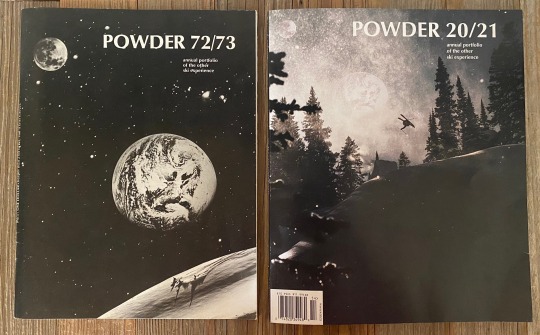
Full Circle - Photo: MJ Carroll
KEITH CARLSEN - Editor
“When I was young, Ski/Skiing didn’t do anything for my spirit, but Powder lit me up. It ignited a passion in diehard skiers and gave them a voice and community. It was focused on the counter culture - the type of people who rearrange their lives to ski. This was in direct opposition to other magazines that were targeting rich people, trying to explain technique, sell condos or highlight the amenities at a ski area.”
“Skiing has always been my outlet and mechanism to get away from things in life. My two talents are writing and photography, so I enrolled at Western State with the direct goal of landing an internship at Powder. Even at 19, I had complete focus on the direction I wanted to take. If it didn’t work out, my backup plan was to be a ski bum. 48 hours after graduating, I was headed to southern California to live in my van and start my position at Powder. When the decision was made to close the magazine, it was really personal for me. Powder had provided me direction in life for the last 30 years and I needed some time to process it. In a way, it was almost like going to a funeral for a good friend - even though it’s gone, the magazine lives on in all of us and can never be taken away.”
“It was, and will always remain, one of my life’s greatest honors to serve as the editor-in-chief for Powder Magazine. It was literally a dream that came true. I’m so grateful for everyone who came before me and everyone who served after me. That opportunity opened literally hundreds of doors for me and continues to do so today. I owe the magazine a massive debt of gratitude. Every single editor was a warrior and fought for the title with their lives. They were doing double duty - not only from competition with other publications, but the internal struggle of budget cuts, staff reductions and trying to do more with less. Powder never belonged in the hands of a corporation. The magazine spoke to an impassioned community and never made sense to an accountant or on a ledger.”

Trevor Petersen, Mt. Serratus, BC - Photo: Scott Markewitz/POWDER
SIERRA SHAFER - Editor In Chief
“Powder celebrated everything that is good and pure in skiing. It highlighted the old school, the new and the irreverent. The magazine also called bullshit when they saw it. It was a checkpoint, a cultural barometer and an honest reflection on where skiing has been and where it’s going.”
“My involvement with Powder came completely out of left field. I was never an intern or established in the ski industry. My background was strictly in journalism, I was a skier living in Southern California and editing a newspaper. I knew that I wanted to get the fuck out of LA and Powder was that opportunity. It was a huge shift going from my job and life being completely separate to work becoming my life. Literally overnight, Powder became everything - friends, connections and part of my identity. It derailed my trajectory in the best possible way.”

Brad Holmes, Donner Pass, CA - Photo: Dave Norehad/POWDER
MATT HANSEN - Executive Editor
“Keith Carlsen was a man of ideas, he had tremendous vision and influence. He came up with the ideas for Powder Week and the Powder Awards in 2001. In some respects those two events saved the magazine.”
“Powder was the soul of skiing and kept the vibe, it changed people’s lives and inspired them to move to a ski town. As a writer I always wanted to think it was the stories that did that, but in truth it was the photography. Images of skiing truly became an art form, 100% thanks to Powder Magazine and Dave Reddick. Dave cultivated and mentored photographers, he was always searching for the unpredictable image from around the world and pressed the photographers to look at things from a different angle.”
“It sounds cliche, but writing a feature about Chamonix was the highlight for me. Sitting on the plane, things were absolutely unreal. I linked up with Nate Wallace and the whole experience from start to finish was out of my comfort zone. Ducking ropes to ski overhead pow on the Pas De Chèvre, walking out of the ice tunnel on a deserted Aiguille du Midi right as the clouds parted, late nights in town that were too fuzzy to recall. The energy of the place taught me a lot. I didn’t have a smartphone and there was no Instagram - I had time to write, observe, take notes and be present with who I was and with the experience. As a writer it didn’t get any better.”
“The true gift of working for Powder, was the once in a lifetime adventures that I wish I could have shared with my family, I was so lucky to have had those opportunities. It almost brought tears to me eyes.”

Peter Romaine, Jackson Hole, WY - Photo: Wade McKoy/POWDER
DAVE REDDICK - Director of Photography
“Just ski down there and take a photo of something, for cryin’ out loud!” “I’ve found that channeling McConkey has been keeping it in perspective. Powder’s been shuttered. That sucks. What doesn’t suck is the good times and the people that have shared the ride thus far and I’m just thankful to be one of them. There’s been some really kind sentiments from friends and colleagues, but this must be said - Every editor (especially the editors), every art director (I’ve driven them nuts), every publisher and sales associate, every photographer, writer, and intern, and all the others behind the scenes who’ve ever contributed their talents get equal share of acknowledgment for carrying the torch that is Powder Mag. There’s hundreds of us! No decision has ever been made in a vacuum. Always a collective. At our best, we’ve been a reflection of skiers everywhere and of one of the greatest experiences in the world. It’s that community, and that feeling, that is Powder. I’m not sure what’s next and I’m not afraid of change but” “There’s something really cool about being scared. I don’t know what!”

Scot Schmidt, Alaska - Photo: Chris Noble/POWDER
DEREK TAYLOR - Editor
“Powder was the first magazine dedicated to the experience and not trying to teach people how to ski. It was enthusiast media focused on the soul and culture. It’s also important to highlight the impact Powder had outside of skiing - today you have the Surfer’s Journal effect where every sport wants that type of publication. However, prior to their inception, everybody wanted a version of Powder.”
“Neil Stebbins and Steve Casimiro deserve a lot of credit for the magazine retaining its voice and staying true to the core group of skiers it represented.”
“Keith Carlsen is responsible for the idea behind Super Park. This was a time when skiing had just gone through a stale phase. There was a newfound energy in park skiing and younger generations, this event helped to rebrand Powder and solidify its goal of being all inclusive. Racing, powder, park, touring - it’s all just skiing.”

Joe Sagona, Mt. Baldy, CA - Photo: Dave Reddick/POWDER
JOHNNY STIFTER - Editor In Chief
“What did Powder mean to me... Well, everything. As a reader and staffer, it inspired me and made me laugh. I learned about local cultures that felt far away and learned about far away cultures that didn’t feel foreign, if that makes sense.”
“But I cherished those late nights the most, making magazines with the small staff. Despite the deadline stress, I always felt so grateful to be working for this sacred institution and writing and editing for true skiers. We all just had so much damn fun. And it didn’t hurt meeting such passionate locals at hallowed places, like Aspen and Austria, that I once dreamed of visiting and skiing. The Powder culture is so inclusive and so fun, I never felt more alive.”
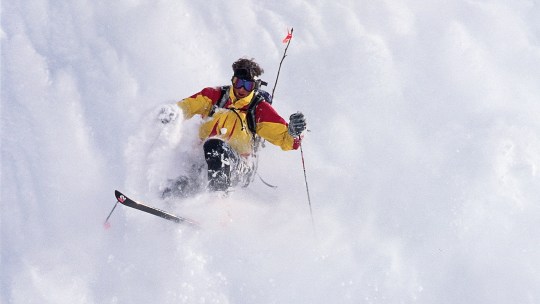
Doug Coombs, All Hail The King - Photo: Ace Kvale/POWDER
HEATHER HANSMAN - Online Editor
“Powder is a lifestyle and an interconnected circle of people. It’s about getting a job offer at Alta, opening your home to random strangers, locking your keys in your car and getting rescued by a friend you made on a trip years ago. Through the selfish activity of skiing, you can create a community of people you cherish and can depend on through highs and lows.”

Ashley Otte, Mike Wiegele Heli, BC - Photo: Dave Reddick/POWDER
The contributions of so many talented individuals made the magazine possible. I would like to express my sincere gratitude to everyone who shared their experience at Powder with me. Also, I want to thank Porter Fox and David Page for crafting inspiring feature stories that I enjoyed immensely over the years.
After the reality set in that the final issue had arrived, a void was created for generations of skiers. I’ve been focused on being thankful for what we had, rather than sad it’s gone. It’s a challenging time for print media and I wholeheartedly advocate supporting the remaining titles in anyway you can. In a culture driven by a voracious appetite for mass media consumption and instant gratification - I cherish the ritual of waiting for a magazine to arrive, appreciating the effort that went into creating the content and being able to have that physical substance in my hand. Thanks for everything Powder, you are missed, but your spirit lives on.

Captain Powder - Photo: Gary Bigham/POWDER
3 notes
·
View notes
Text
All-Star Superman #2
A scant year to the day since part 1!
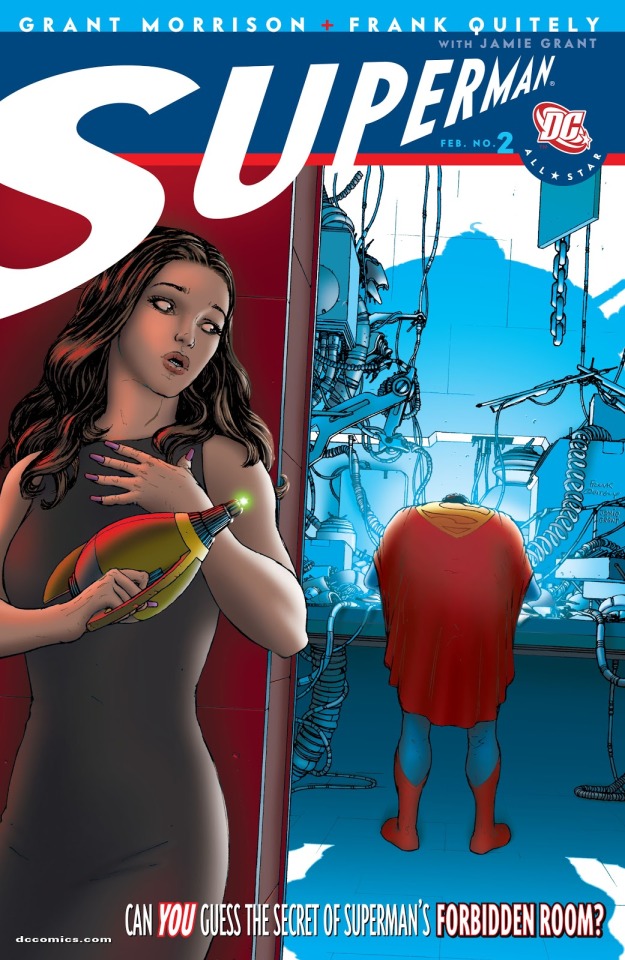
All evidence to the contrary I actually have always wanted to go back to this, especially since I keep getting asked if I’ll do so and it stirs my omnipresent sense of guilt over my lack of productivity, and also the last year has not resulted in a mass turnaround of people realizing it’s a for-real good book and not just comfort food so this remains necessary. This isn’t going to be quite as in-depth as the first go-around - both that as the introductory issue and that as the introductory recap had a lot of groundwork to lay - but still plenty to cover, as this issue sets up Lois and Superman’s arcs for the series, which is rooted (amazingly, especially right off the bat, given the book’s reputation of being about how amazing Superman is) in how badly Superman’s let his fears and shortsightedness poison the most important relationship in his life.
If the first issue is the big classic Superman material - Superman saving the day from the monster! Lois and Clark and the rest of the Daily Planet crew! Lex Luthor’s sinister schemes! A ticking clock to doom! - this scales all the way down to the uncomfortably, stiflingly intimate. Classic archetypal Superman stuff gives way to the most Silver Age issue: casual huge ideas, relationship drama, misunderstandings, last-minute reveals that recontextualize the entire issue, and baaaarely latent psychodrama bubbling up at the edges. In service of that the visual framing here is not unlike a stage play, a limited set of physically connected locales as a pair of figures bounce off one another. Quitely and Grant’s work is therefore comparatively subdued next to issue #1, keeping to traditional panel layouts and wide or medium shots with a background color palate of mostly blacks and whites and grays with a handful of other colors popping out...until Lois starts to lose her shit at the end of the issue and we get close-ups and full black and white panels and eerie glowing and dutch angles and that unsettling abstract image of her clenched teeth, as the story starts to squeeze us like Lois’s gut.
She’s right to be unsettled for that matter; she’s alone on Superman’s turf (the one issue where that’s the case other than #6, and that one’s about how Smallville stopped being his home), the weird antiseptic alien lair of the ultimate super-hobbyist, and all the baggage of their relationship is spilling out into the open as she has less and less reason to think the best of this odd man who’s been lying to her for years. Unlike the Silver Age tales this is referencing, she’s absolutely on the money with her complaints about him: he’s been dicking around with her forever and thinks it can all be okay now (His little “What?” on the second page when she bursts his bubble says it all), and he’s awkwardly overcompensating trying to fix it.

While the Fortress tour serves to peacefully acclimate us to how utterly bizarre Superman’s world really gets past the traditional rescues (the little cubic starfield we don’t know the meaning of yet, trophies are floating rather than physically suspended, the glowing flowers in Lois’s room, “The Phantom Zone map room’s pretty dull unless you can see radio-negative anti-waves”), Superman himself is...humblebragging isn’t the right way of putting it, but it feels like he’s working way, way harder than he ever will again in this book to be cool and impressive and assuring. He’s a dope in love, but he can tell something’s up and that super-brain of his isn’t putting the obvious pieces together, or noticing that this is just putting her off further and further until, like Bluebeard’s wife before her, she stumbles through the threshold of the door she was never meant to, even of course in the end he’s still Superman and there’s a perfectly good reason. Not a good enough reason, however, for her accusations at dinner to not hit home - his mind may be expanding, but he’s still way up his own ass here in a genuinely unpleasant way that’ll be elaborated on momentarily. For now he’s left stammering that she should trust him and it’s limp and phony, especially compared to his big entreaty for someone to trust him in #10 (which’ll be right after he finally comes clean with her); while Superman may not be considered a savior figure by his friends in here the way he often is in the mainline comics Lois seems to be the only one who doesn’t look up to him at least a little bit, but that clarity means she’ll call him out where no one else will.
Across the next two pages it’s all laid out, and we get to the roots of where things have gone wrong between the two of them. Lois is paranoid, certainly, the panels are literally squeezing in on her, but with Superman seeming so out-there and alien like never before she would have every right to be even sans alien chemicals. But notably there remains throughout a part of her assuming the best of him wondering if maybe this is just another big misunderstanding or that he’s simply been mutated by the solar overexposure. And in her heart of hearts, she admits that maybe she wants this to be another big damn trick with a completely sensible justification, because the alternative is that this is the new normal and she has to accept that he’s a flawed mortal man. It’s ugly and it’s mean - especially since she likes Clark - and it’s human as hell in the worst, most understandable way. It’s not going to be until said mortality is staring her in the face that she’ll be able to accept it.

Superman, meanwhile...someone could write a thesis on these panels as an articulation of the Superman/Clark dynamic. The Mirror of Truth is actually preexisting, centerpiece of a Jerry Siegel/Curt Swan joint in Action Comics #269 that was later adapted into the Superman newspaper strip where Lois uses it to figure out Superman is Clark Kent until he tricks her into believing the mirror can lie, after which he tosses it in a volcano; here it’s survived, and curiously shows him as Superman rather than Clark, when in the original tale it displayed Kent even though that was fully the era of Clark as a disguise. In here too it’s Superman who’s the ‘true’ identity of the two and which this time is reflected in the mirror, yet as in #1 it’s Clark who says what he’s truly feeling. In that light, the final panel of the abandoned glasses reads like nothing so much as Superman using the mirror as affirmation that the truth of the solemn, steadfast Superman identity gives him licence to deny the uncomfortable emotions his squishy human farmboy side is dredging up, ‘lying’ to him in a way he had to fake in the source material. Those emotions however knock right on the door of what he can’t grasp here: Clark’s so wrapped up in his own head trying to do the ‘right’ thing that he’s overlooking how his attempts at self-sacrificing selflessness are hurting the people around him. Throughout the series he’ll come to rely on others, first at his lowest points with Jimmy and the Bizarros, until at last he comes to invest true trust in Lois, and the Kandorians, and Leo Quintum, and even Lex.
For now though Lois is deep in a hole, a brief but memorable meeting with the Unknown Superman of 4500AD - everything Superman seems to be becoming to her even before she wonders if it’s literally him, cryptic and masked and with a big ‘ol question mark right on his chest instead of the familiar comforting logo, even his gutbuster of a question reinforcing his distance from a recognizable human experience - leading her all the way to reimagining her Silver Age ideal happy ending of marriage and family with Superman as a Cronenbergian horror. It’s still a Superman story, it turns out he had the very best reason possible for wanting to keep her in the dark, but right through to the end he remains just a little condescending in his reassurance, and his gift of essentially bringing her up to his ‘level’ isn’t going to solve the problem. While the next issue lets us see the two of them properly in love, it won’t be until the elephant in the room comes out that they can come to terms.
Additional notes
* God Quitely is so good. Look at the way the seatbelt curves in the first panel! Lois’s bemused little disbelieving smirk!
* Pages 2-3: Aurora Borealis?!
* Lois is the only character other than Superman who gets to have actual narration (in both cases as looks at their in-text writing), the only one whose viewpoint is thus privileged in the same way as his.
* The key is the realization of this series’ aesthetic in a nutshell: the old-school idea in a sleek, shiny, clever new way that doesn’t take away from the fantastical toyeticness of it all. For that matter, the key is the centerpiece of a later bit with Superman that could be fairly described as the long-term goal of the book book as Morrison’s hoped-for perennial: “One day some future man or woman will open that door, with that key. When they do, I want them to know how it felt to live at the dawn of the age of superheroes.”

* This is A. The first note of a larger DC universe existing offscreen, something that I’ll go into more when discussing #8, B. A brilliant, concise, fun little summation of his place in Superman’s world, and C. Absolutely hilarious given Morrison suggested in his exit interview that this could be seen as much later on in the same universe as All-Star Batman & Robin The Boy Wonder, which entirely rewrites the tone of that moment.
* Already discussed the key but the muscles in Superman’s hand tensing a bit at picking it up is another great detail.
* The glimpse of the Fortress here is excellent: the statues of his friends and enemies instead of pictures because he does things bigger with the yellow electric something crackling at the end of it, the off-model but curious-looking robot appearing to glance at Kandor (are it and the bigger robot with the seats on top of it trophies, or Superman Robots with different designs tasked for specific purposes?), the classic Bad Penny Good For One Crime, the Legion time bubble that establishes his time-traveling credentials for later, the Titanic where he and Lois will dine when their relationship hits a proverbial iceberg, and most strikingly the space shuttle Columbia, his apparent rescue of which I have to imagine is a reference to Astro City’s Superman analogue Samaritan debuting by averting the Challenger disaster.
* It’s next issue that has my actual favorite Superman/Lois moment of all time, but “When we’re married fifteen years, when I’m sagging and he looks just the same, will he still meet me and say things like...” “These are for you. I picked them on Alpha Centauri 4.” is right up there.
* The technological aesthetic of the Fortress is so different than P.R.O.J.E.C.T., sleek and solid and cleanly-lit and antiseptic, beautiful and advanced but a little cold in its own way. As stuffed with wonder as this place may be, there’s something hauntingly empty about it, suiting both the tone of the issue and as a physical embodiment of Superman’s emotional state. The one part that goes against it is the forbidden room, it even has beakers and test tubes to sell the mad scientist vibe...though if you were to stretch it, it much more close resembles the human technology seen at P.R.O.J.E.C.T., and this is meant as a gift for one.
* The cosmic anvil made it along with the key into the CWverse, Lois used it in Elseworlds! I may not be expecting All-Star quality from the upcoming Superman and Lois, but it’s good to know the powers that be are using it as a reference point (beyond how it inspired Supergirl’s take on Cat Grant, a connection I discussed in a post that seems to have vanished into thin air). The whole page is perfect, Superman at his most joyfully benign and beautiful and godlike; it’s the one bit where Lois’s skepticism cracks a touch watching him feed his adorable little Lovecraftian abomination from beyond the stars.
* While he never appears physically aside from a statue Brainiac hovers over this series from beginning to end in name and deed, the ominous ultimate enemy of Superman’s past, the great trial overcome even as the scars forever remain. Morrison mentioned in the exit interview that he didn’t appear in here because he and Quitely already used him as the villain of JLA: Earth 2, but that if he had it would have borrowed Superman: The Animated Series’ take on him as a Kryptonian AI gone rogue. Personally I like his place in here as-is, a little totem parallel to the Justice League references indicating the breadth of Superman’s history between putting on the cape and Luthor’s final scheme.
* A pair of minor notes: Lois points at Superman with the pointy fork when asking him pointed questions, and while it’s not immediately clear on first read she does in fact ask the Unknown Superman exactly 3 questions (“Kal Kent?” “Will Superman and I ever marry and have children?” “What do you mean?”) before he replies with his own, as promised.
* “Oww.” and “Tickles.” literally could not be more perfect Superman moments.
* Worth taking a moment to marvel at just how many future plot elements are seeded here. There’s the obvious bit of Superman thinking about having a partner setting up the next issue, but we also for issue #6 have our first look at Kal Kent and Lois wondering “What if (the Unknown Superman) was really (Superman)?” when Clark will indeed pose as him, for #10 we get our first look at Qwewq, and for #11 not only is the Sun-Eater introduced but so is Robot 7′s malfunction as a result of Luthor’s tampering.
* The structure of the series according to Morrison is a solar cycle, beginning and ending at midday with nightfall in the center. If last issue was the sun at its brightest we begin the descent here, with Superman remaining larger-than-life and ultimately trustworthy but with his classic persona and habits held to an additional, unflattering degree of scrutiny.
#All Star Superman#Superman#Lois Lane#Grant Morrison#Frank Quitely#Jamie Grant#Phil Balsman#Art#Silver Age#Clark Kent#Batman#All Star Batman & Robin the Boy Wonder#Fortress of Solitude#Astro City#DCTV#Brainiac#Opinion#Analysis
38 notes
·
View notes
Text
How to Do Nothing: Jenny Odell's case for resisting "The Attention Economy"

Artist and writer Jenny Odell (previously) is justifiably beloved for her pieces and installations that make us consider the economics and meanings of garbage, weird markets, and other 21st century plagues; in her first book, How To Do Nothing: Resisting the Attention Economy, Odell draws on art criticism, indigenous practices, "Deep Listening," anti-capitalist theory, and psychology to make the case that the internal chaos we feel is no accident: it's the result of someone's business-model, and until we reject "productivity" in favor of contemplation and deliberation, it will only get worse.
Odell's central thesis is hard to pin down; part of her subject-matter here is that really important ideas don't neatly distill down to short, punchy summaries or slogans -- instead, they occupy a kind of irreducible, liminal complexity that has to be lived as much as discussed.
With that in mind, the broad strokes of her book are that:
* The rise of "productivity" as a measure of the quality of life is incredibly destructive, and it obliterates everything inside and outside of us that make us happy, because sleep and love and laughter and beauty are not "productive."
Odell links this to neoliberal capitalism, and the requirement that each of us be a hustling entrepreneur, which, in turn, is a way for capital to shift risk onto labor. It's a scam that moves both wealth and joy off of our balance sheets and onto the balance sheets of the super-rich.
This is very strong material, and it reminds me of the one conversation I had with David Allen, author of "Getting Things Done." Allen lamented that everyone pays close attention to the first two parts of his book (which focus on making sure that the stuff you decide to do get done) and skip over the third part (which focuses on deciding what to do).
* That doing "nothing" doesn't mean becoming a hermit: it requires more social engagement, not less
Odell builds on the idea that capitalism atomizes us and makes us stand alone and think about our relations to others in instrumental, individualistic terms; the reason social media is toxic isn't that it connects us with others, it's how it connects us with others. Doing "nothing" (that is, spending your time doing "meaningful," rather than "productive" things) requires that we find ways to genuinely interact with others.
This reminded me strongly of Patrick Ball's incredible essay on depression and suicide, and the reason that affluent white dudes are the most suicidal people in America today. Ball's thesis is that people who lack privilege must forge social relations with the people around them just to survive. If you have no money for a babysitter, you can substitute favors from friends.
"Favors from friends" are unreliable and nondeterministic, while spending cash with a sitter (or better, a service that has many interchangeable sitters) is extremely reliable. But if you keep substituting transactions for social networks, you'll eventually end up lonely and outside of any kind of social group that can form a resilient mesh for your inevitable problems: there's no one to put a hand on your shoulder, look you in the eyes, and say, "Are you all right? You seem to be in trouble."
Reading Ball's essay made me realize how much of a hermit I'd become, substituting work and transactions and "productivity" for friendship and connection, and how much of the anxiety and depression I was experiencing was the result of this isolation.
Social media is a great way to stay in touch with the people who matter to me, so that we can have offline, longer-form, important and meaningful interactions. But the commercial imperatives of social media work against that kind of socializing, because once you get together and start to have those contemplative and meaningful interactions, your social telephone starts ringing, because the algorithms that govern it notice that you're not paying attention to it anymore.
* That refusing to pay attention is an act with a long and honorable history
Odell traces the traditions of refusal from the ancient Greeks to avant-garde artists, and connects these to feminism and liberation struggles. This was fascinating context, and often very funny, and felt like something of a masterclass in understanding abstract art as well
* That cities have unique properties that make them hubs of resistance
The struggle against our reduction into productive workforce units, as opposed to thriving, contemplating, loving humans is the struggle against monoculture. Cities, with their diversity of people, backgrounds, incomes, social situations, and so on are the perfect place to resist monoculture. Places where strangers mix, like public transit, are hotbeds of resistance.
Odell also lauds "third places" here, the places that are outside the market, like libraries and parks, where your welcome is not dependent on your productive contributions, which ask nothing of you except that you be there.
And even as Odell is praising cities here, she's also working in a strong environmental message, connecting refusal to indigenous practices of attentive co-existence with the natural world, and connecting that to the complex idea of "bioregionalism," which involves identifying as a person whose place matters, whose views on the world and daily activities are influenced by the things that grow and thrive around you.
I've been around "bioregionalism" advocates for much of my life, and I admit I still struggle with some of the nuance of this idea, but Odell's connection feels right, and I really enjoyed the way she connected the beauty of cities -- which I love -- with an appreciation of, and connection to, the natural world.
* That technology isn't the problem, but rather, its economic and political context are what get us in trouble
This is the argument that puts Odell in the same group as some of my other favorite thinkers, like Leigh Phillips, Paul Mason, and Peter Frase.
Like the others, Odell doesn't argue the simple position that technology is neutral, but rather takes the position that technology's current decidedly partisan configuration is the result (and not the cause) of market ideology that demands growth, consumption and "engagement" instead of joy, meaning and peace.
It's an important point: Odell isn't telling us to stop using technology, but to use different technology in different ways.
There is so much to love about this book: Odell's discursive, interdisciplinary critique approaches an important and difficult question from many different angles, making it a chewy, provocative pleasure of a book.
But all that said, I'm looking forward to her next book. I know from my own work that what feels like irreducible complexity is often a lack of clarity. That is, just because you think you've made something as clear and simple as it can be, it doesn't mean you're right, it might just mean that you don't understand your own material well enough, and have not spent enough time trying to explain it to other people in order to learn what parts of it are important and which parts can be left to one side.
As much as I love this book, I also think that there is room to make it crisper, and some of that room will come from Odell gaining clarity as she tours with and discusses these ideas, and some of it will come from the rest of the world catching up with her -- when we started talking about online privacy, there was a lot of getting-up-to-speed that had to happen before the discussion could start. Today, the baseline of familiarity that others have with the ideas is much farther along, and so the discourse is more substantial and less about getting on the same page (this is also true of other complicated debates, including the contemporary critique of capitalism and concerns over climate change).
That's not to say that Odell has fallen into the trap of the masochistic longread ("because paying close attention to complicated ideas is a virtue, I will simply write this idea out in sprawling and undisciplined form, because the longer it is, the more virtue it has"). This book never bores. However, it does leave the reader with more feelings (which are good and important!) than clear articulation (also good and important!), and I think that Odell's continuing trailblazing will find a place where these two virtues are more in balance.
How To Do Nothing: Resisting the Attention Economy [Jenny Odell/Melville House]
https://boingboing.net/2019/04/09/resisting-attention-economy.html
48 notes
·
View notes
Text
“Violence ends by defeating itself” - Dr. Martin Luther King, Jr
In the film Do the Right Thing by Spike Lee, we go through the day of different people who live in the same part of town, but mainly follow the main character Mookie. Throughout the film there are a lot of heated moments between individual characters, but also clashing groups of people. We slowly watched the progression of Buggin Out’s anger towards Sal due to the problem he had with the pictures on Sal’s wall. In Christian Metz piece, Some Points in the Semiotics of the Cinema, he states “Thus a kind of filmic articulation appears, which has no equivalent in photography: It is the denotation itself that is being constructed, organized, and to a certain extent codified” (68) He speaks of how in film, there is a kind of buildup of different elements. Such as the building of a character, or like in the film we watched today, the building up to a turning point. We saw Buggin out constantly try to gather people to boycott Sal’s Pizzeria and then eventually Radio Raheem joined him and that was a different turn of events because everyone else had turned him down. The scene I want to focus on is when the violence exploded on screen with Sal breaking Radio Raheem’s radio, and then the outburst of anger from the characters which eventually led to Radio’s death. We saw Radio join Buggin Out on his boycott, and we could sense something was coming. Then there was the build up with the music in the background and even the change of camera angle which was unlike previous in the film. The spectators could sense something was going to happen by the surrounding context just like Metz said. He also speaks of how a film can signify a certain meaning. This meaning would be different for each spectator as we interpret things differently as individuals, but for me this scene signified how quickly things can change in your life. In this one scene, Radio Raheem loses his life and the community burst out in rage and violence while for Sal, he lost his life’s work, his way of providing for his family, and an employee who he considered family. Life changes in an instant.

3 notes
·
View notes
Text
Summarize this for a high school graduate: Eighty days ago, Apple's Senior Vice President of Software Engineering ~~stood up in front of a crowd of~~... No!... It was just me... Alone, in my mother’s basement, on a Monday morning, contorted at stupid angles, typing to my phone with a physical keyboard and unapologetically scarfing as much as I possibly could of the Apple community’s unbelievably unreserved, almost spiritual volume of pure hype from as many simultaneous sources as I could manage. (Hilariously, all of said sources are/were Discord servers, now, as in that “gamer” communications service I launched my little indie mag on in 2015 and kept comparing to Slack, but like an actual madman.) Anyway, said Senior Vice President of Software Engineering (who we are encouraged to hold accountable for basically all technical changes to iOS) is named Craig, and these are his first few sentences: For many of us, our iPhone has become indispensable. And at the heart of iPhone is iOS. iOS powers the experiences we've come to rely on. This year, we were inspired to create even more meaningful ways iPhone could help you. Our new release is iOS 15. It's packed with features that make the iOS experience adapt to and complement the way you use iPhone... I’m dwelling on them because they are patently meaningless. Very little to nothing coming in iOS 15 is what I would call ease-of-use-centric. Some of it – namely controversial (and now backpedaled) changes to the user interface of Safari – feels almost maliciously quartered in the opposite direction. Most of the changes in the subheadings of the full feature list are simply irrelevant in the use for all but the dorkiest iOS users, like myself, and I find the fact unacceptable, at the very least. The Foundation Image This is why I would like to try something different, this year, and focus on an entirely different audience: my family, as representatives of the vast majority of the iPhone’s billion-something demographic (read: customers.) That is to say, who Craig should be referring to with the phrase “most of us.” Not because I believe them to be “dumb” or “end users” (in the tech bro derogatory sense,) but because they are busy, working people who depend on their iPhone as a utilitarian device, above all else. They don’t have the time to dive deep into Apple documentation or watch the whole WWDC presentation to gain an understanding of where to look for new features or (unfortunately) how to turn them off. Realistically, they don’t even have time to read this whole Post, though I hope they will (sorry fam.) Regardless of how we feel about it, Apple has made it clear that our phones are going to be further and further inundated with automated processes in the background. Whether you like it or not, your phone is going to be used to help find other users’ devices over the Find My network, your travel information is going to be used to inform Apple Maps’ live traffic statistics, and so on. For the more conservative members of my family, related truths about their phones are going to continue to feel like we are continuing to give up “ownership” of our devices. There are definitive alternatives, but they involve giving up a whole lot of conveniences. I will do my best to address this a bit later on, drawing from much more articulate criti…
0 notes
Text
Research: Project Defuture The Future
Randolph Lamonier
Randolpho Lamonier, is a visual artist from Minas Gerais, born in 1988.
He developed several works, specially photography articulated with other languages. He deals with several daily experiences in the city as a form of work, in which photography leads to multiple forms of symbolic exchange.
His work moves between different media, with a leading role in the practice of textile art, drawing, photography, video and installation. In his research, word and image are always together and tend to talk about micro and macro politics, urbanities, sentimental lies, chronicles, diaries and multiple crossings between memory and fiction.
The work done in fabric and embroidery brings sentences like: “ In 2040, we legalized love and other less intense drugs”, and is part of a set of creations in which Lamonier elaborates predictions based on thoughts about the present. “ I always create these works from guidelines that I consider urgent”, explains him.
In the words of the artist himself: “I make flags with what I have. I have never been so foreign. I draw poems, calls for help, war cries, everything is very urgent. The air is contaminated, the floor is covered with debris; sheets, pots, ropes, concrete, broom. Under the rubble the seeds grow in a hurry”.
Perhaps something more interesting than his incredible flags, are the themes he addresses, most of the time making a prediction of the future, about things that could happen in Brazil.
He is indignant with everything rotten that has in Brazil, from the corrupt government, the uncontrollable drug trafficking, the misogynistic society that still exists in Brazil and in several Latin countries, up to the violence itself.
He creates these flags in order to have some kind of hope for Brazil in the future, creating an utopia, where the problems would be thrown away.
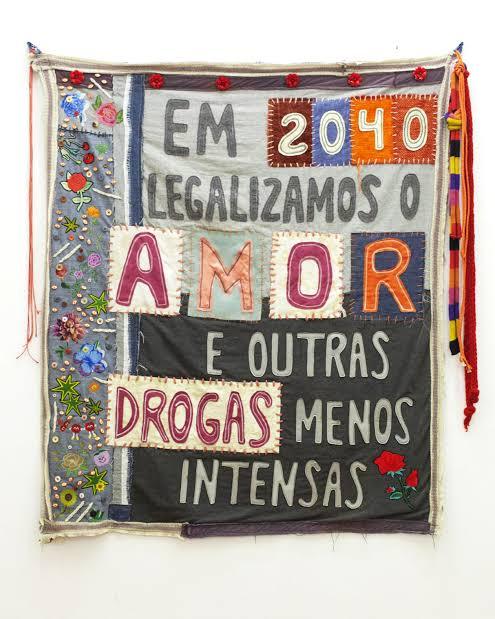
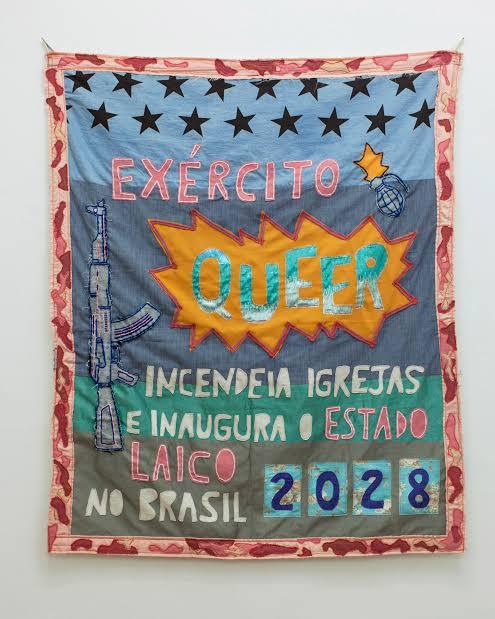

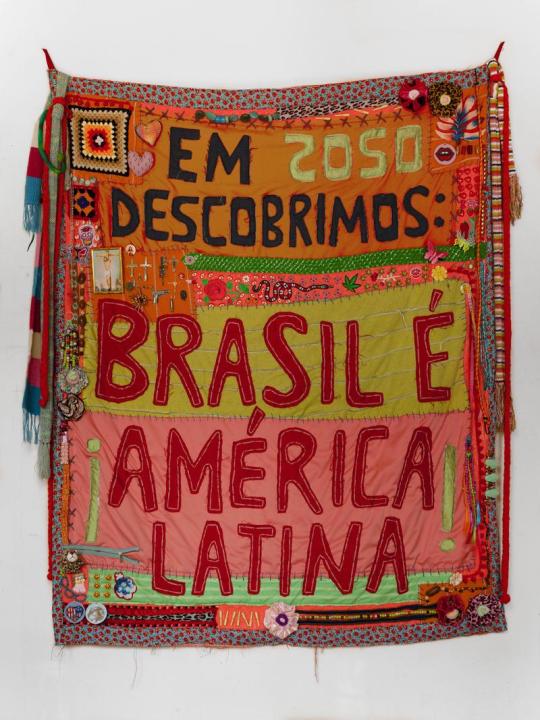
David A Smith
Is a British designer who is specialized in lettering.
He started his own company own sign writing company in 1990 and after 13 years sold the business in 2003 to concentrate more on hand crafting lettering and glass gliding. His main techniques include water and oil gliding, acid etching, French embossing, screen printing and sign writing.
His career in sign writing began in 1984, when he left Westlands school in Torquay, age 16 and was apprenticed for 5 years with Gordon Farr & associates. They were a traditional sign writers, who had come up through the ranks and Gordon, had an uncanny ability to paint letters, accurately laid out, without even a sketch. Under their tutelage, David became an accomplished draftsman, and a accurate letter painter.
This gathering of talented sign artists, carvers and muralists experts. David passion for creating elaborate, ornate mirrors&reverse glass signs of distinction.
In 1992 he set up his own business in England dealing every aspect of sign trade from vehicle graphics to 3D installations.
In 2012, Smith was hired by the singer John Mayer to design the album cover, of ‘Born and Raised’. The cover was styled like 1900 trade card.
He has also worked on posters and other merchandise associated with the album and single.
He was also commissioned by Jameson Whiskey to design a st.Patrick’s Jameson Whiskey bottle for the brand.
David sold the business, to concentrate more fully on gilding, painting e acid-etching glass, adding cutting, so that he could fully replicate the Victorian glass work he admire so much.



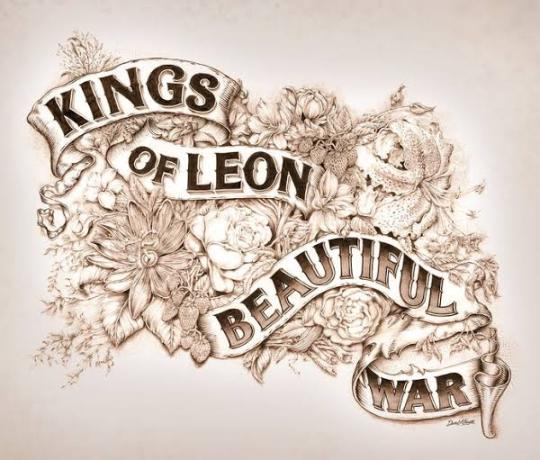
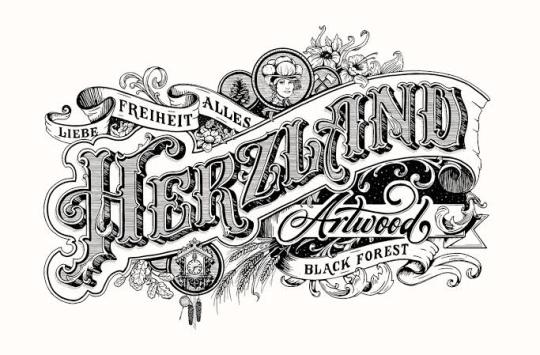
Thomas Burden
Burden is a senior designer at the design boutique “I Love Dust”.
He likes to produce work that references the pieces of vintage tat and printed material he gets from car boot sales and junk shops. Thomas Burden has created work for book covers, ad campaigns, music videos and magazine editorial to packaging, and even animations.
Thomas Burden was always encouraged to be creative, he was allowed to draw murals on the walls of his house, when he was very young. He had many references to do his drawings, in his grandparents house, full of Alpine memorabilia and indigenous art.
Toys weren’t allowed in Burden’s life as a child, so he was always looking at catalogs full of brightly colored things.
So in his works he tries to transmit that nostalgic journey to his childhood memories.
In each work there is a maximization of colors and textures and his great influences are: the film director Wes Anderson and the artist Mark Ryden.
On his own words: “ I was lucky enough to have a pretty idyllic childhood. I grew up sailing and skiing and traveling, so our house was full of souvenirs that parents collected, along with various bits of old boating junk and pieces of old cars”.
As an 3D illustrator / Art director from UK. He had worked with many different clients such as Nickelodeon, The New Yorker, Apple, McDonalds, Penguin, Bloomingdales and Ford.
His signature style is mainly the toys that he was never allowed as child, combined with fairground / neon signage and anything bright and fun that catches everyone’s eyes. He create works in Cinema 4D, also using the Adobe Illustrator, Photoshop and After effects.
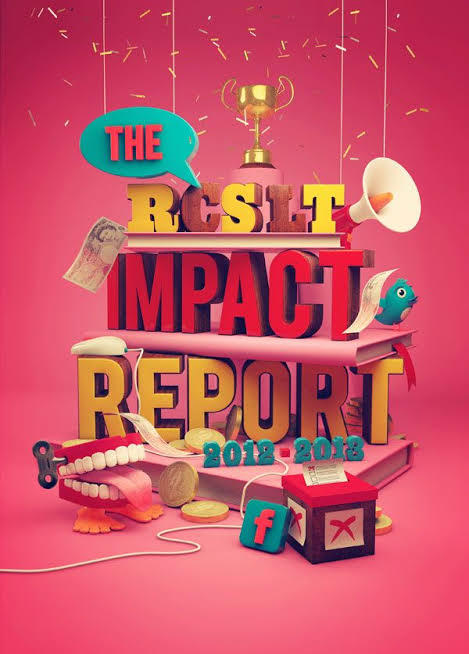
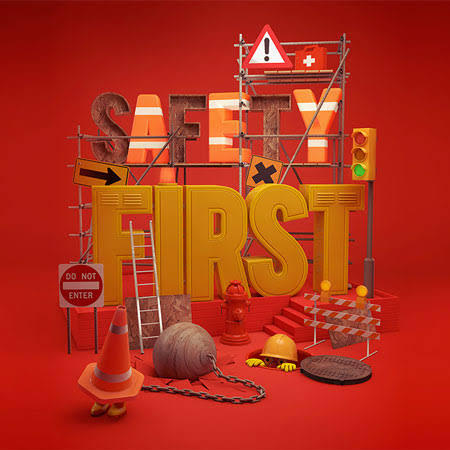
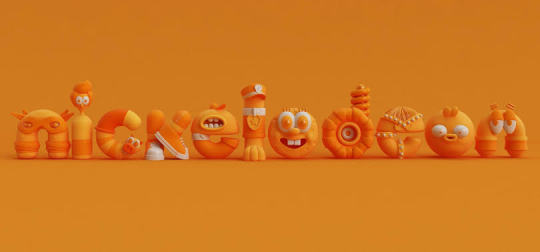
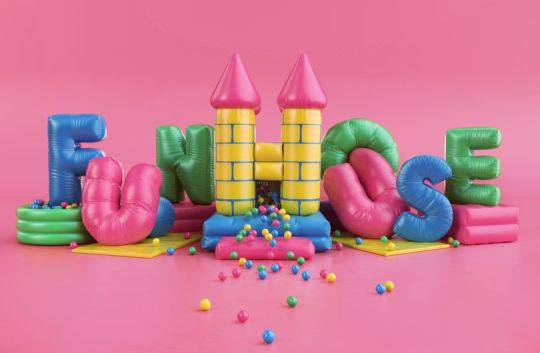
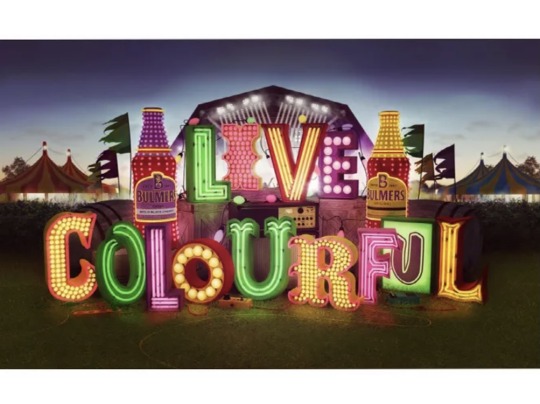
Barbara Kruger
Barbara Kruger is a postmodern artist who was born in 1945 in New Jersey. Having grown up in a middle class family, her first job was as an operator. In 1965 she graduated from The Parson Design School in 1965 and worked as an art director in different magazines.
By breaking some barriers of the modern art, Kruger and other women artivists ( art + activism) demonstrated not only against the bonds of patriarchy in society, but also within cultural production. Being an artistic medium an environment built largely by male hegemony, feminist art presents itself as a mean of liberating women.
Her works examine stereotypes and the behaviors of consumerism with text layered over mass media images. Rendered with black and white, with a red background, Kruger’s works offer up short phrases such as “Thinking of You” and “I shop therefore I am”.
Kruger uses language to broadcast her ideas in a myriad of ways , including through prints, T-shirts, posters, photographs, eletrônico signs and billboards.
Despite the work of feminist artists of the twentieth century to change the way women are portrayed in the art world, today this representativeness still confined by a backward ideal. Thus, the work of Barbara Kruger proves to be even more relevant and undoubtedly necessary today.
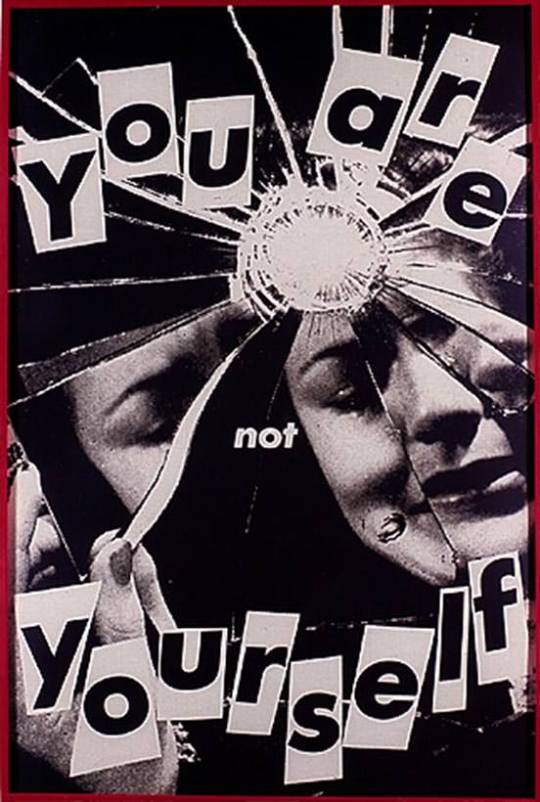
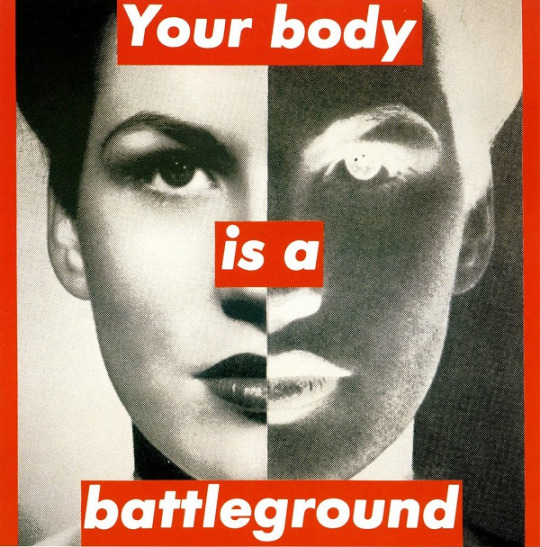
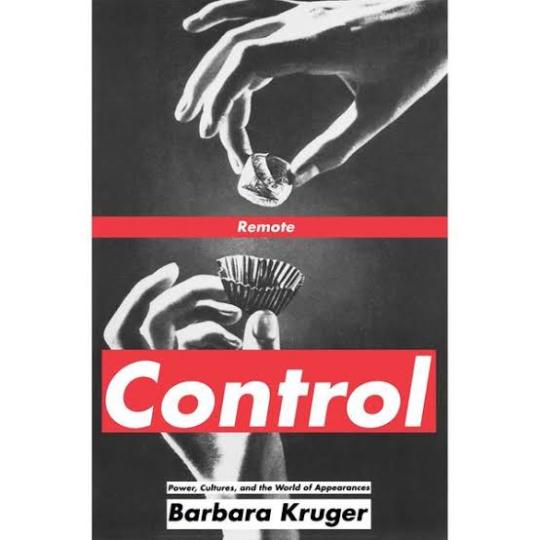

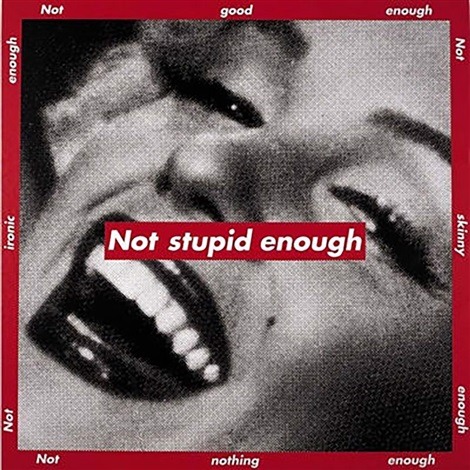
Mike Perry
Mike Perry is an artist that makes paintings, animation, sculptures, books, public art installations, monographs, silkscreens and more.
Mike Perry was born in Missouri, United States, and grew up in Kansas City. He started drawing at the age of four.
He attended to the College of Art in Minneapolis, and earned a degree in graphic design.
Mike Perry's style of using extremely vibrant colors, and making totally stylized designs with a lot of personality is something that draws my attention mainly.
His letters are always around a totally imaginative space, which can be both a forest and even a city.
The creativity in making those compositions for his posters is something very captivating, not necessarily making a poster that matches with the reality, but doing something perhaps lysergic.
His works can be considered love notes to the abstract, unknowable future that is all possible in the present.
Illustrator Ana Benaroya said that , “Mike Seems like a modern surrealist to me. His works feels like a childhood memory of slipping down a giant water slide during summer.
Slippery and wet and innocent but not innocent. His drawings feel like they just fell right out of his brain onto the paper”.
I think he is a great influence, especially for this project. Because I'm wanting to go overboard with the lyrics and the drawings, wanting to do something totally experimental, doing something absurd and creative at the same time.
And with this nature theme, I want to make posters with extravagant animals and unconventional scenarios.
How he uses photoshop and Procreate for most of his work. I would like to use Photoshop again for this job to continue to learn painting techniques.

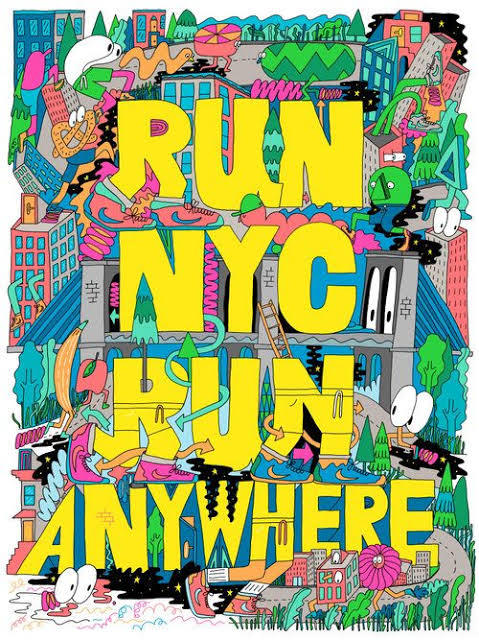

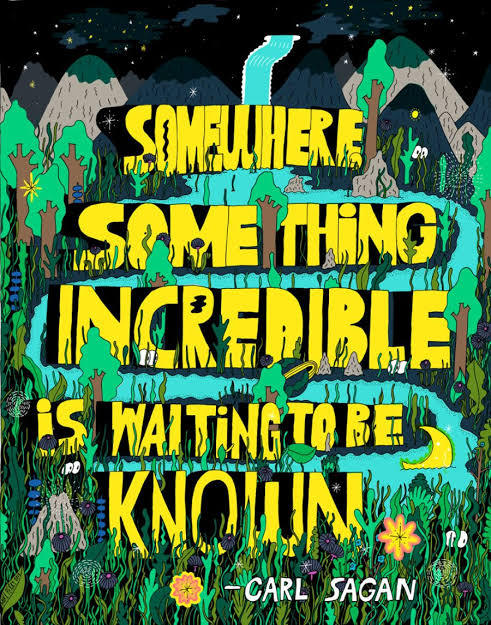
Filipe Grimaldi
Filipe Grimaldi is a lyricist and designer. He has been working in the graphic design market since 2006 and, in recent years, has been focusing on the study of manual techniques of calligraphy, lettering and letter painting, migrating part of his work to the development of letterings and commercial decorative painting.
He even give practical classes in ateliers of other institutions. His works can be seen on walls, slates and thousands of plaques that circulate around with his characteristic traits.
Filipe Grimaldi works on the primary chromatic contrast, a key element for the graphic construction of the alphabet.
Letters, words and sentences are organically raised, avoiding the precise math of right angles.
I met Filipe Grimaldi at EBAC in 2019, when he taught a class of typography, teaching how to make a freehand letter. I was impressed, because I saw great perfection and lightness when he drew those letters.
In addition to using several very vibrant colors in his works, even looking like a lettering of an entertainment show.
He even painted on a mural at EBAC, where even I had the opportunity to give a light brushstroke in one of his letters.
For 13 years, Filipe has been specialized in manual techniques of calligraphy, lettering and letter painting. In his own words: “ My authorial research and commercial activities ended up leading me to rescue the calligrapher profession, an almost extinct activity in the development of technology and printing and clipping machines”.
Currently, he teaches typography and calligraphy, for college students, with the goal of encouraging people to try more hand-made letters.
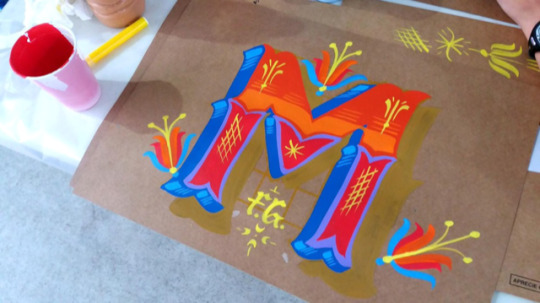

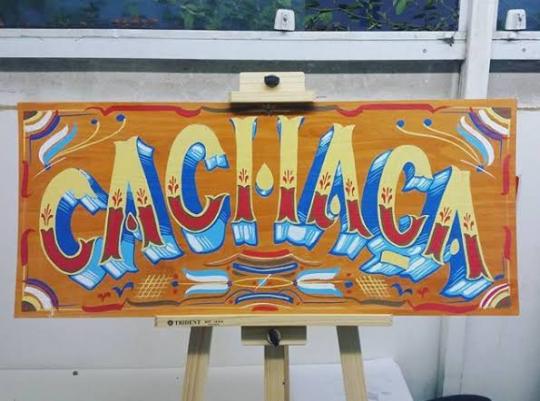
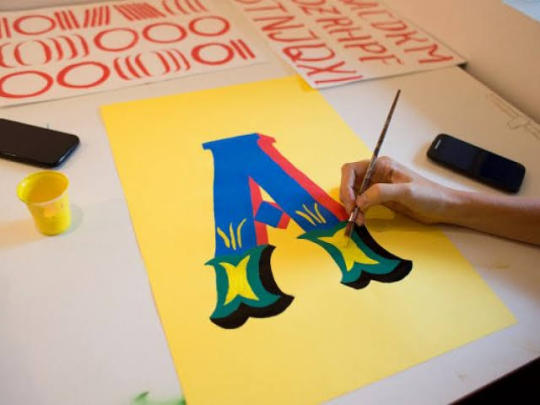
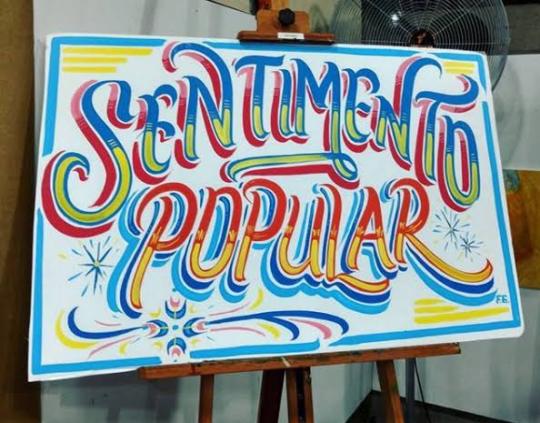
Wayne White
Wayne White is an American artist, typographer, cartoonist and puppeter.
A former set and character designer for the television show Pee-Wee’s Playhouse, White produces ironic, often subversive imagery.
On Pee Wee’s Playhouse where his work for his set and puppet designs won three Emmys; he also did many voices on the show.
He is best known for his word paintings composed of oversized, three dimensional text painted onto cheap landscape paintings he finds at thrift stores and markets.
In 2000, he began painting words and phrases, on thrifted lithographs. “When you think about it, you’re surrounded by giant letters and words everywhere”. White said once. “We don’t take for it granted, but the whole American landscape is nothing but a giant letter forms”.
One Journalist said his opinion about White’s paintings: “the weirdest landscape painter in America, White uses master painting techniques to create the illusion of words and phrases surreally disappearing into the horizon or jutting out from each lithograph’s place setting.”
White’s famous “word art” paintings hang in museums and galleries across America.
His paintings features technically proficient and wildly colored phrases that are funny and sarcastic. And critics have praise White’s series for being entryway to the artist mind.
Over the past years, White has worked primarily as a fine artist with solo exhibitions of his paintings and sculptures in galleries in New York and Los Angeles. In 2006, he created a giant head sculpture, with a giant lettering next to head. This marks one of White’s other passions, which is sculpting, and he like to exaggerate on the expression, of the characters that he is sculpting.
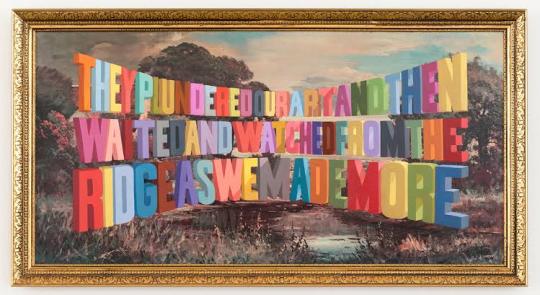
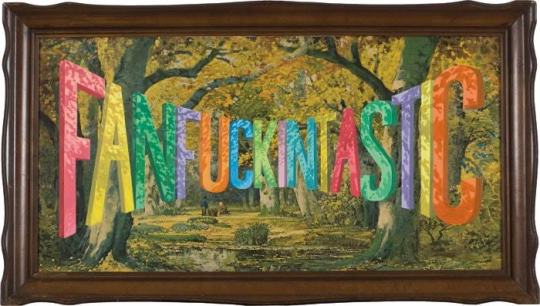
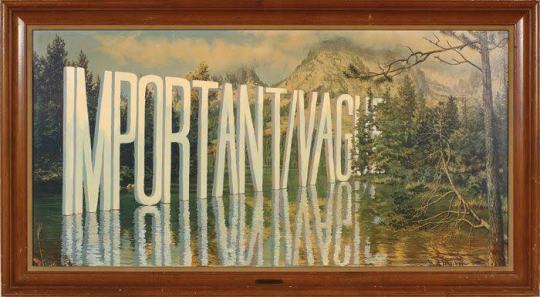
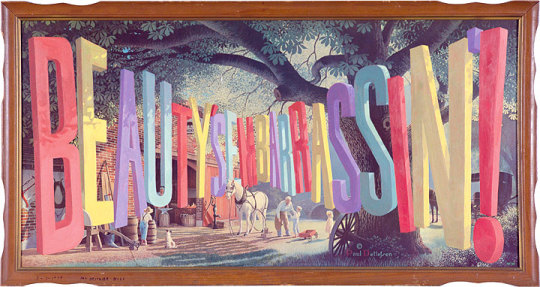
Joshua Noom
Joshua Noom is a famous illustrator who was born in Australia, in 1988.
He is very popular in the social networks, specially in Instagram, where his minimalist illustrations and typography have earned him over 60,000 followers. He had created several illustrations for musicians and major brands like, Miller High Life, Sony, and Warner.
Today Noom lives at Florida, and he is specialized in detailed and bold illustrations combined with an organic sense of typography.
One of his most recent works, was recreating the Bible’s cover, with many other Christian artists.
Each artist offers a visual entry point focused on a particular biblical theme or passage, setting a tone of reflection as readers engage with the Bible.
I’ve been looking at Joshua works, and I really like the feeling of gritty and inky that he puts in his illustrations. Some of his works feels military inspired and masculine, while other pieces feel soft and feminine, like some vintage postcards that he produces.
Something that Josh uses in most of his work, and that connects with my posters, is the use of wild animals and different situations.
It can either make a tiger surfing, or even protest posters for the preservation of wildlife.
He has a very intense passion for animals, and he enjoys drawing them in very expressive ways. With strong colors, with its minimalist style, and texts with different fonts around it.
In a interview Josh even discusses his style “ My inspirations for my style are mostly from music and other art, but one artist that I’ve been diggin’ is Mark Conlan.
My style has just kind of developed over the time and I think I will probably keep evolving. After many attempts of trying new things and figuring out what works for me, and what doesn’t for me. I prefer to draw in a more minimalist style, specially using my ink pens.
Animals are one of my inspirations, specially here in Florida, we got many different species of birds and reptiles, so like to sit somewhere, and draw any animal that appears, and try to create a composition with different typefaces, to make future posters.

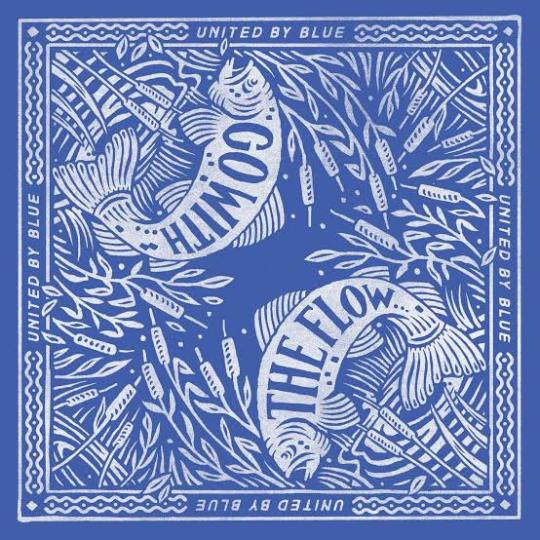
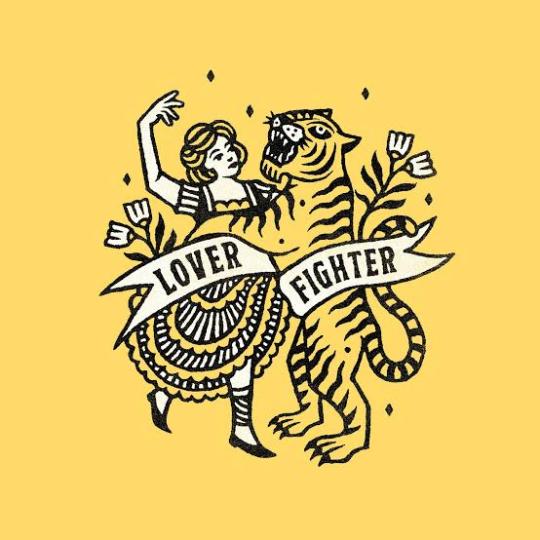
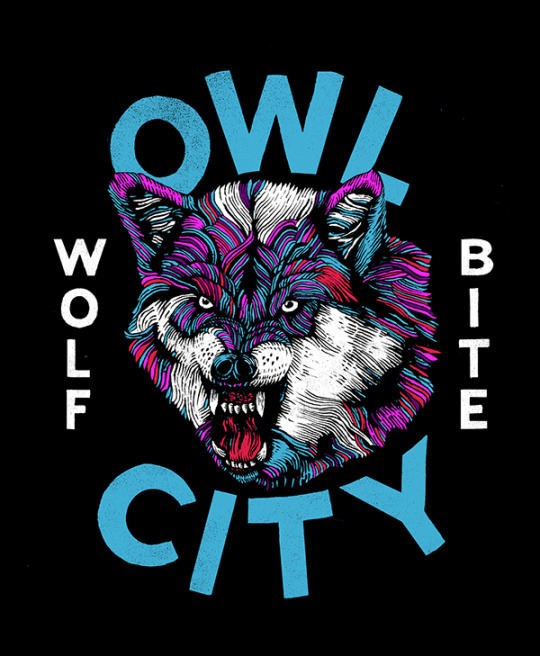
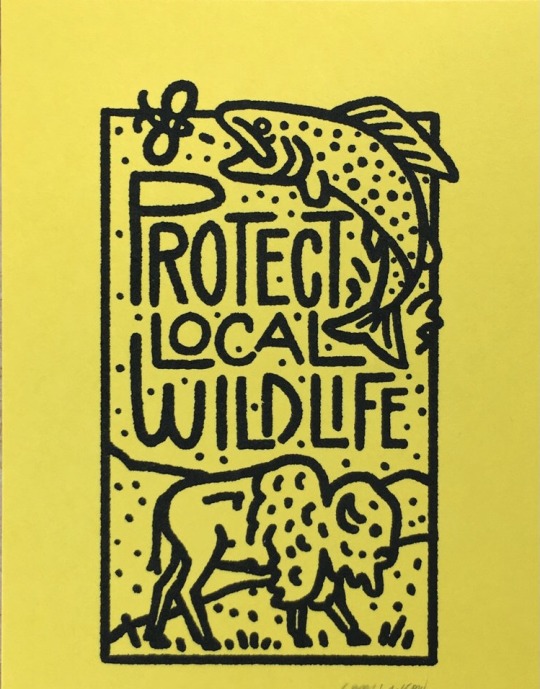
1 note
·
View note
Text
Why Firms Need Collaboration Strategy

Collaboration is said to take place when two individuals or a group of people work together by sharing their ideas and skills to achieve a common goal. It can occur in both the traditional and virtual teams. With advances in technology, it has become commonplace to use collaboration software to share and communicate files.
Companies should encourage their teams to collaborate as.
It Encourages Self-Analysis
Collaboration challenges people to think, articulate, and understand their skills. It serves as a mirror providing them with an insight into their strengths and weaknesses.
This Helps Solve Problems
If a variety of expertise and skills are pooled, a larger, more capable, more willing, and more experienced talent pool is developed. Digital teamwork minimizes or even removes the financial and technical requirements. Businesses can achieve greater customer access thanks to the Internet and companies can succeed with people from diverse backgrounds.
It Shows the Larger Image
No two people are the same, and if you have a lot of people working for you from different backgrounds, you'll need to learn how to take advantage of the differences and realize how they can support each other. You will need to realize that if the project might not form the way you expected it to, the relationship will also accomplish more at the end of the day. You do have to realize that if the project doesn't form the way you expected it to, at the end of the day the relationship will still achieve something.
It is Teaching
When your teams work together, they learn new things essentially from each other. Your organization becomes a body that fosters a culture of continuous learning and supports learning through growth and development opportunities as well as through failure safety networks. We improve their capacity to reach outside their comfort zones and drive the company to new heights while team members work together.
Collaboration Advantages
Talent and Strengths pooling- The knowledge, experience, and skills of all involved can be used by team members when working together.
Effective teamwork should allow all the participants to share their experiences and find the best solution to any problem. This would increase the company 's chances of doing more in less time.
Employee Skills Development- Collaboration is mutually beneficial for both the workers and the company as they see and understand how others work, think, negotiate, and function while working together, communicate, and exchange ideas. This offers all the workers an opportunity to collect expertise from their colleagues or teammates and draw on their strengths. Then it is possible to use these recently acquired skills in their profession and look at issues from a different angle and make changes and improvements.
Accelerates things-Collaboration speeds things up. It keeps on progressing quickly. A problem that can take months to solve when approached by a single person, but when many other participants use their specific insights and experience to do something, it may take only a few hours to solve. Such views can open the doors to numerous ideas and approaches that a single person might not be able to come up with.
0 notes